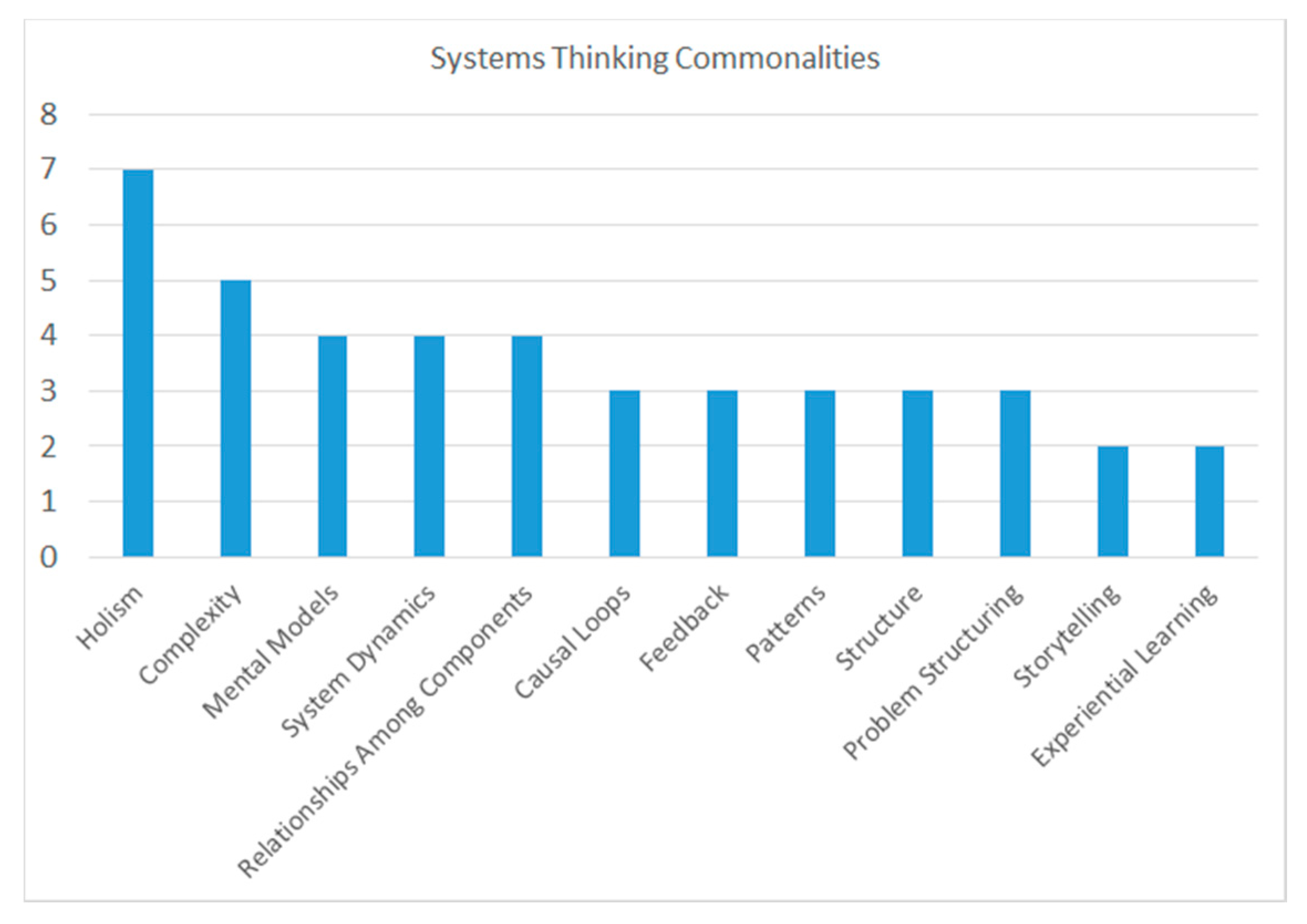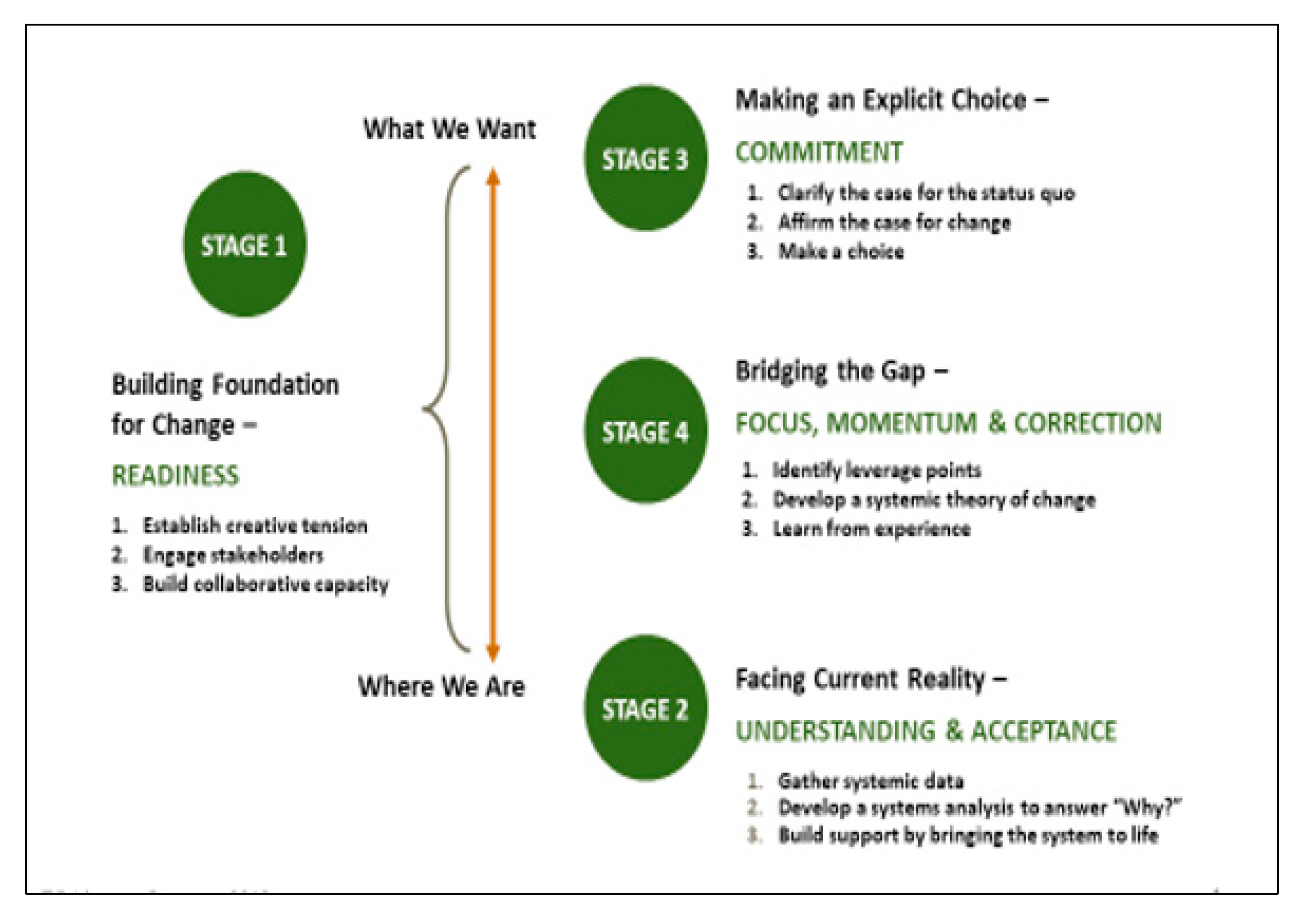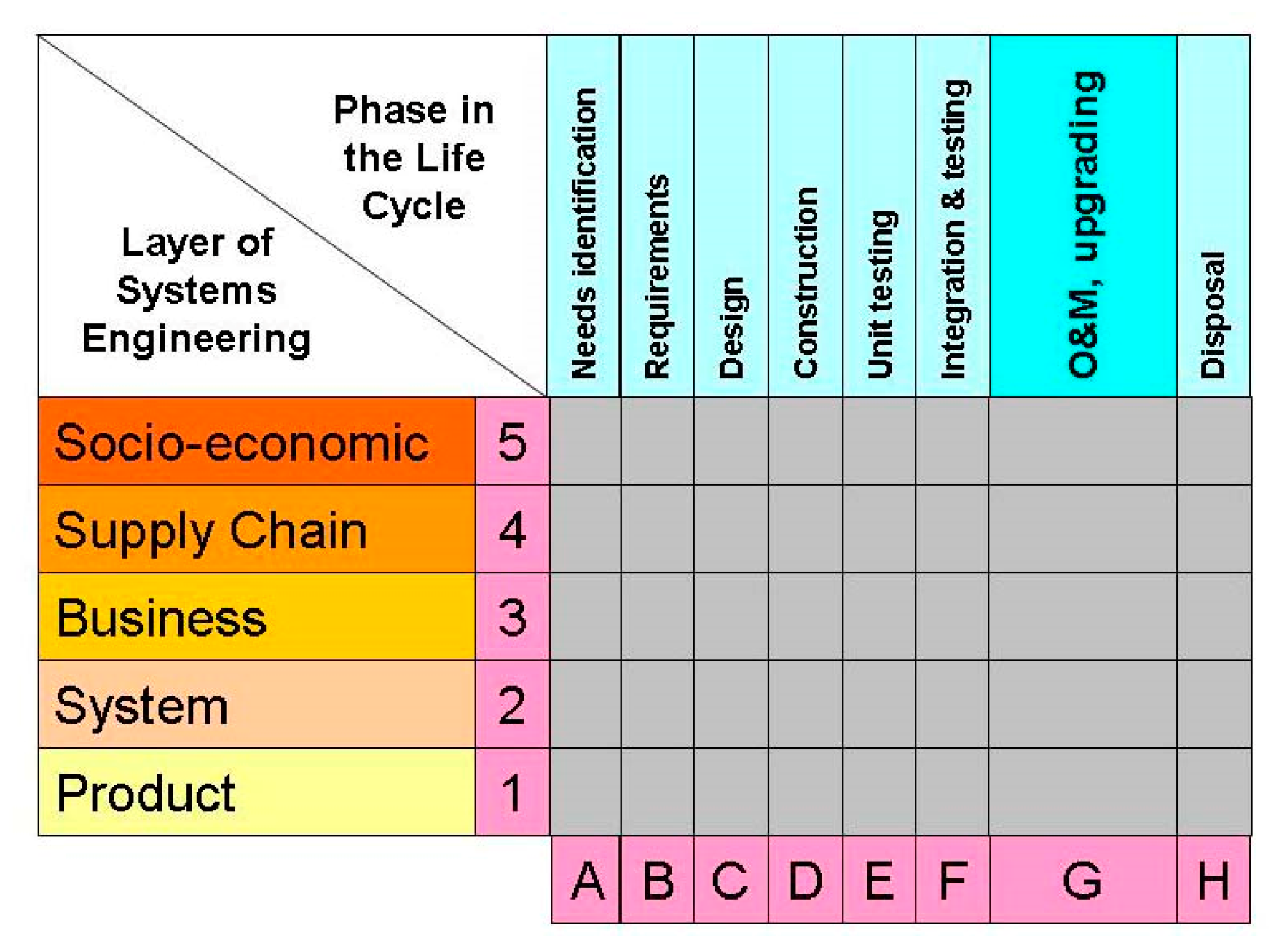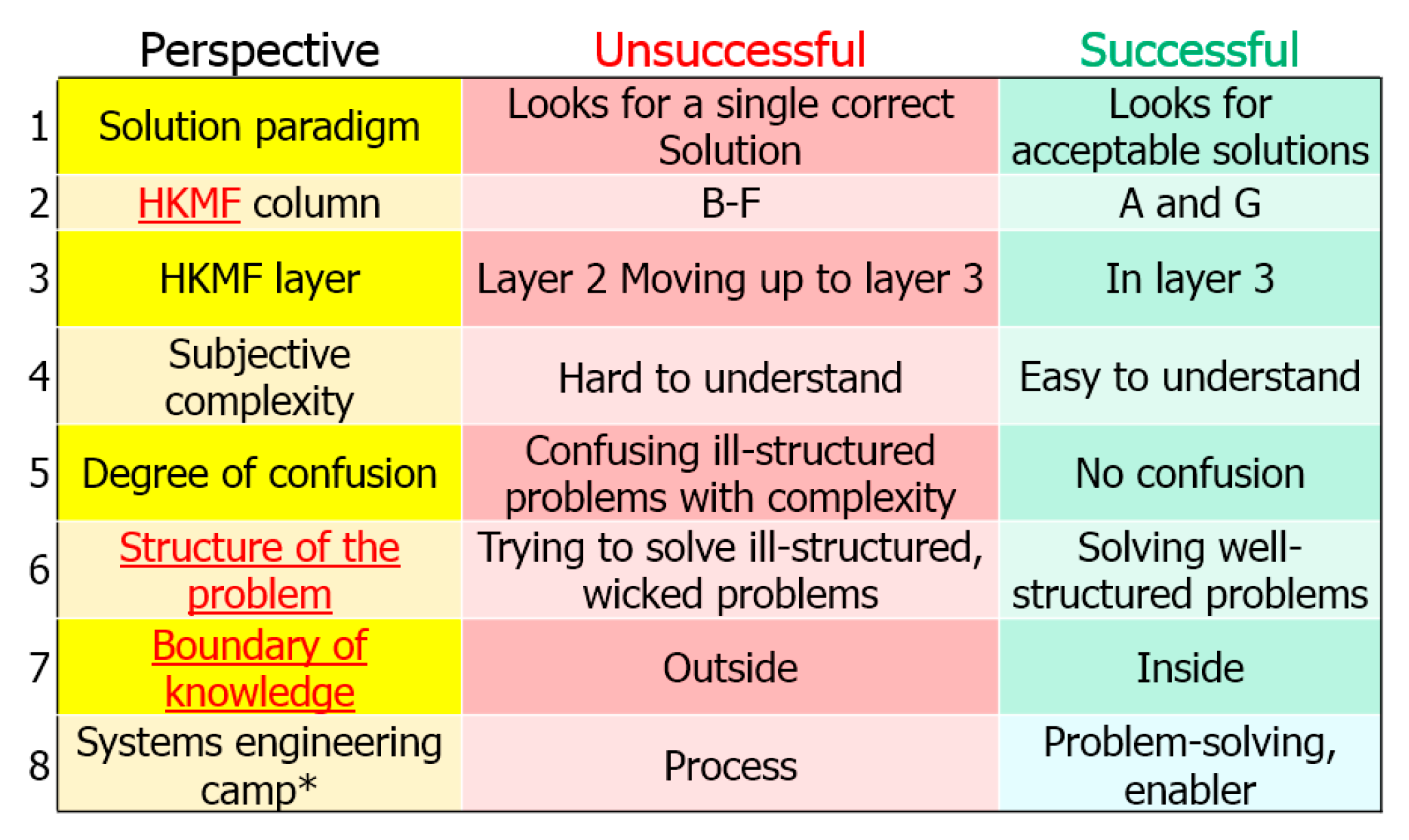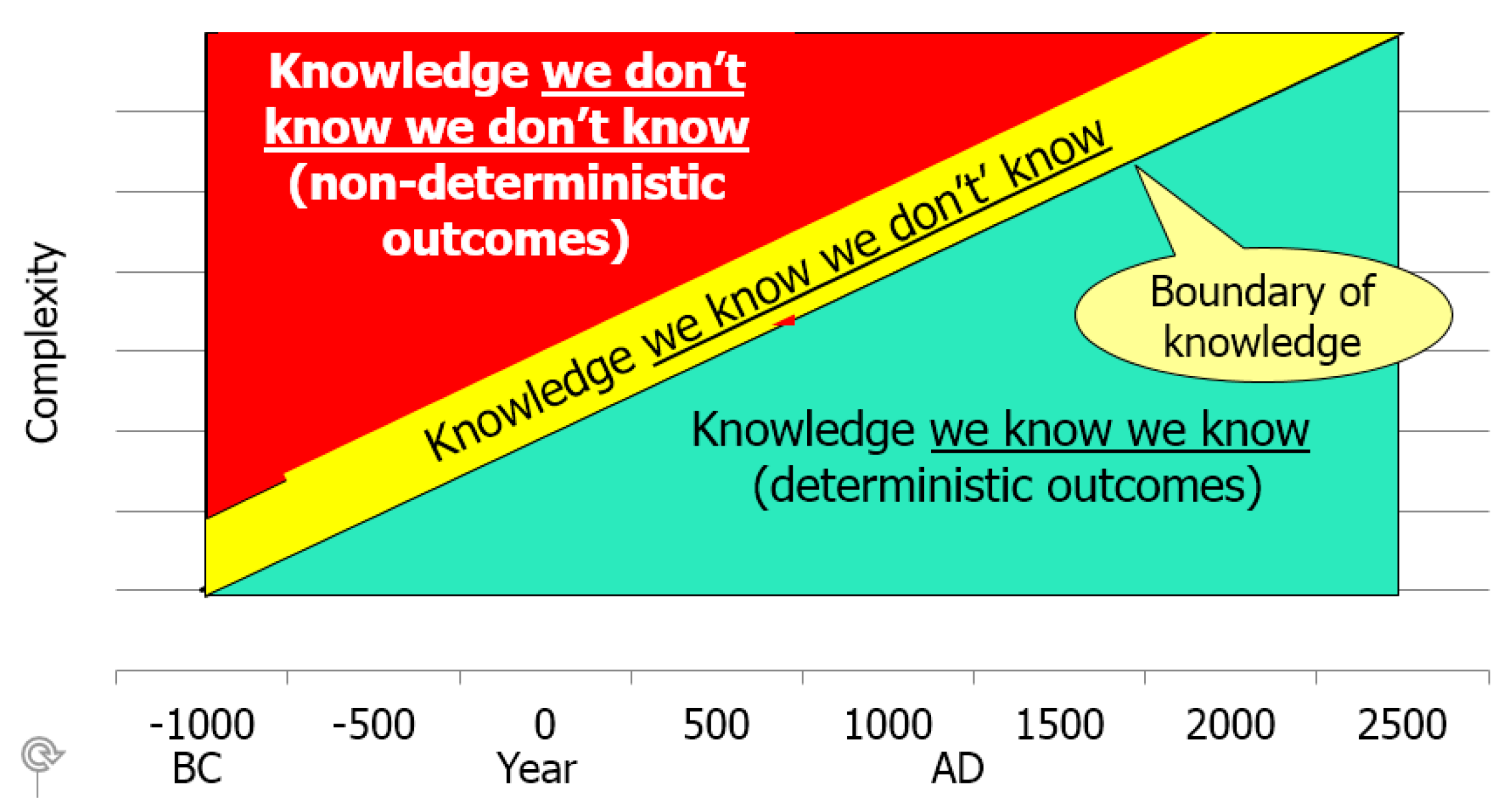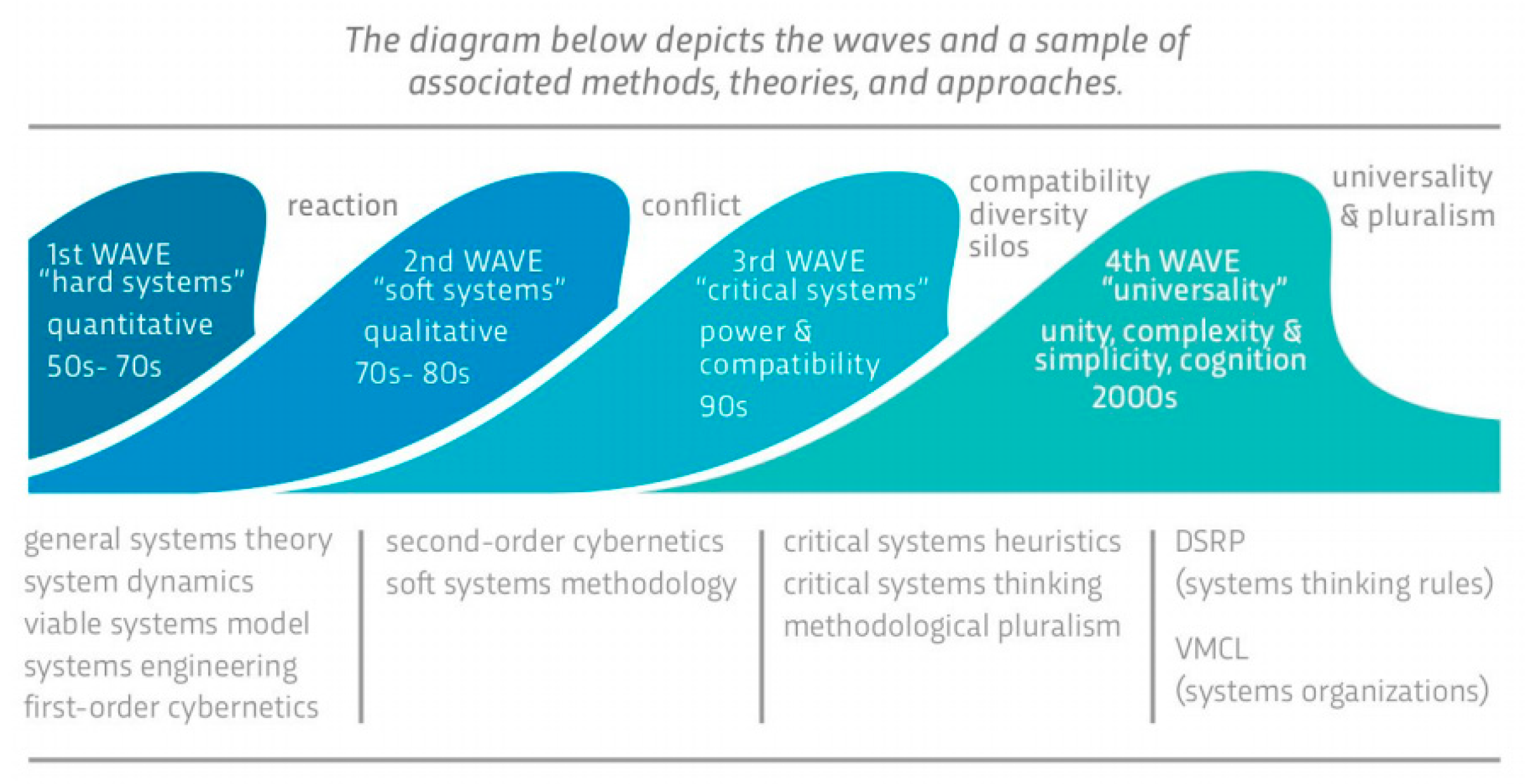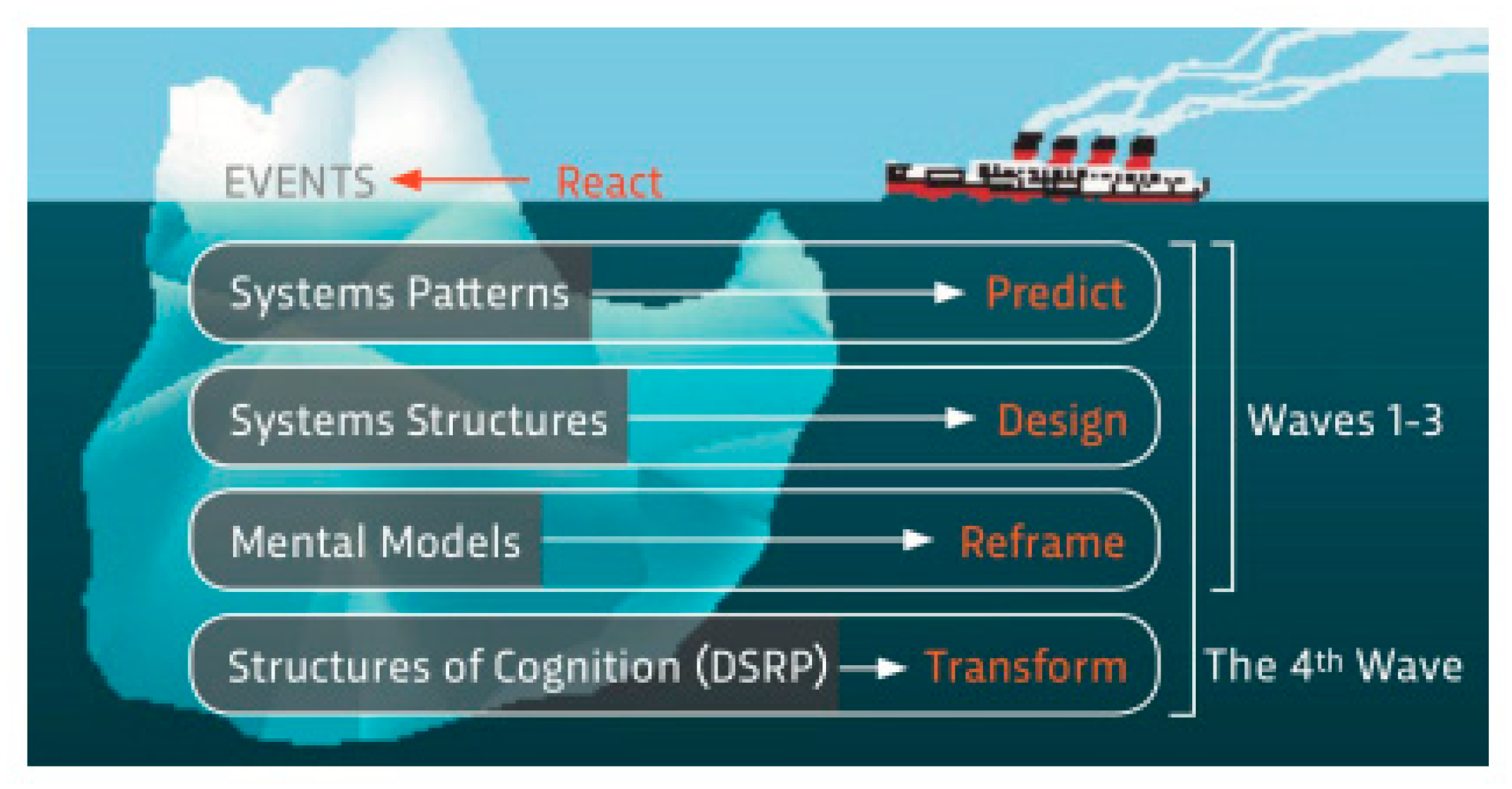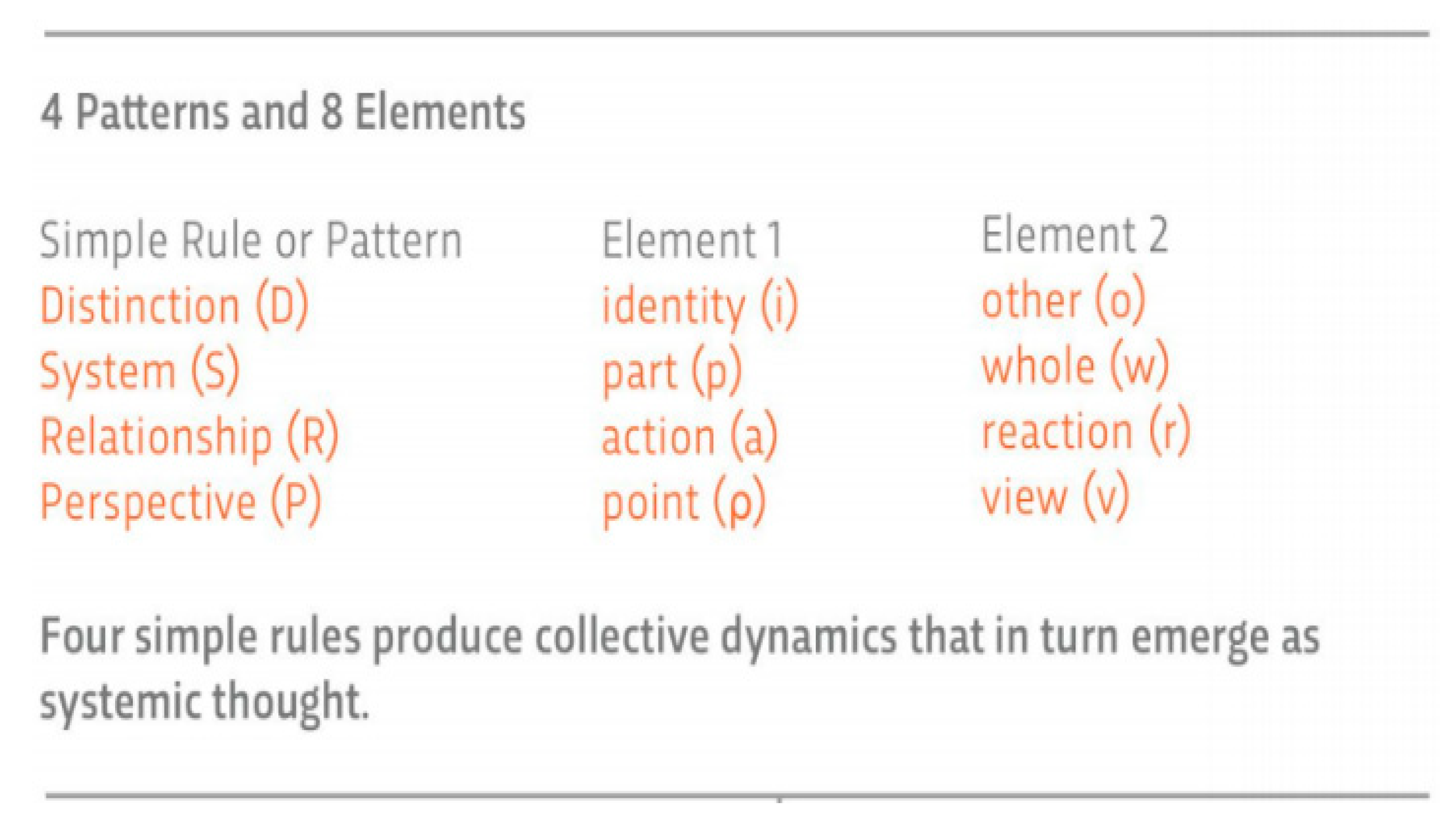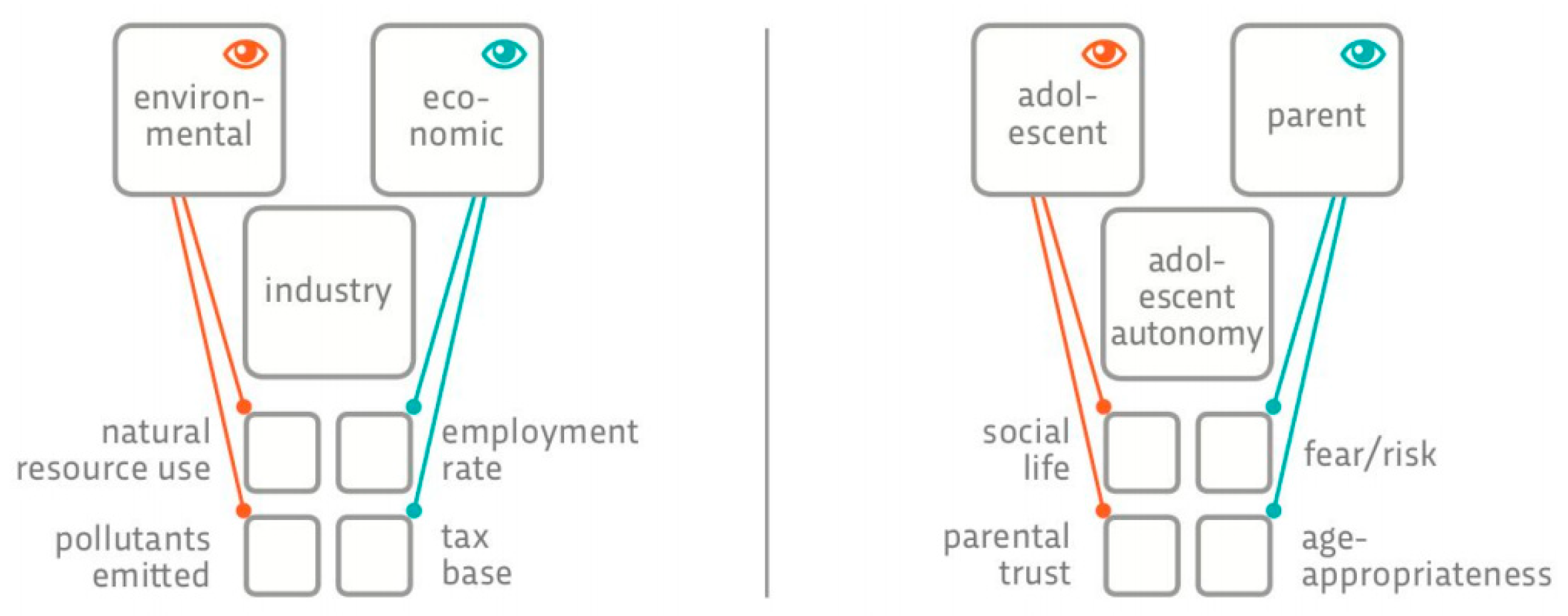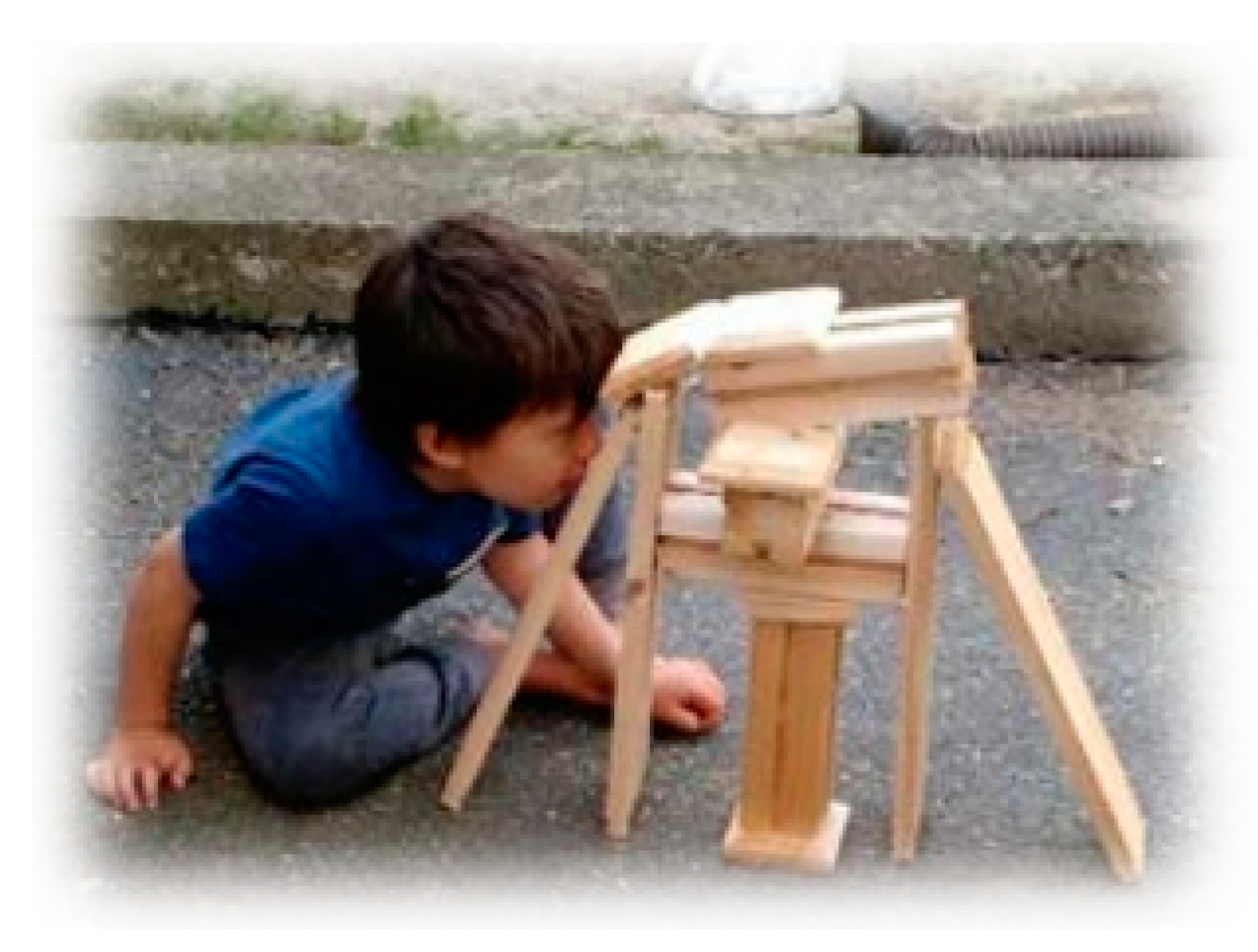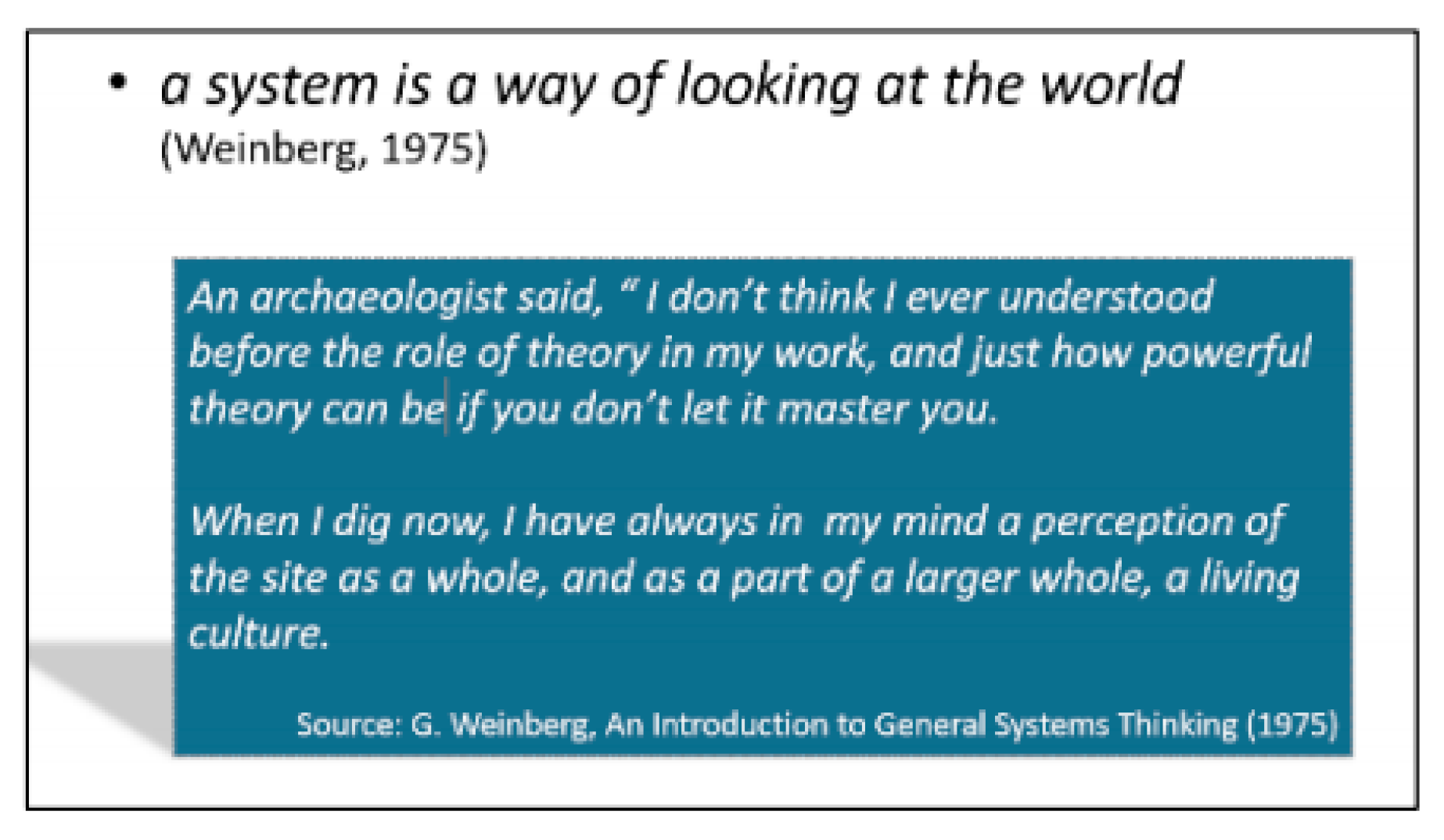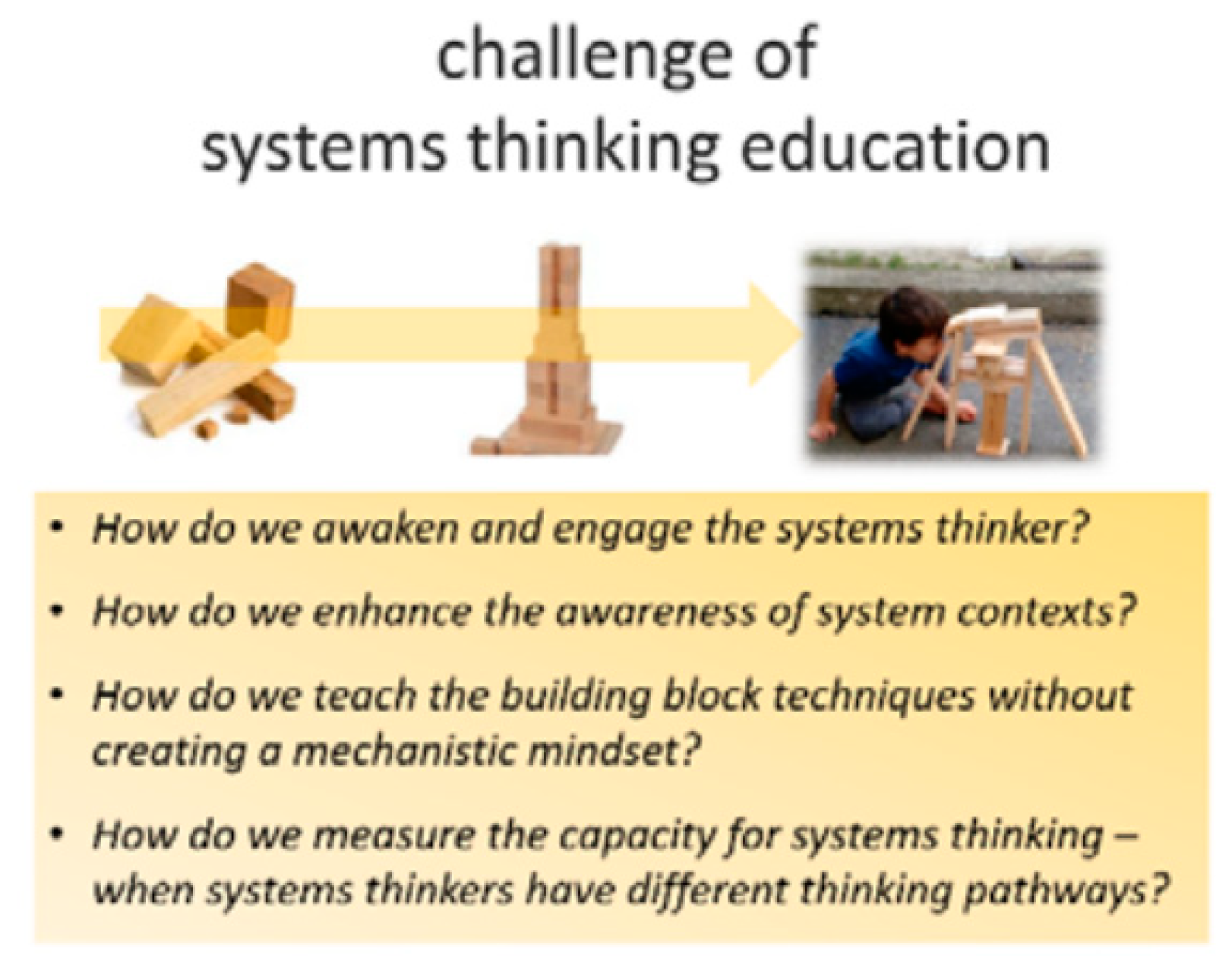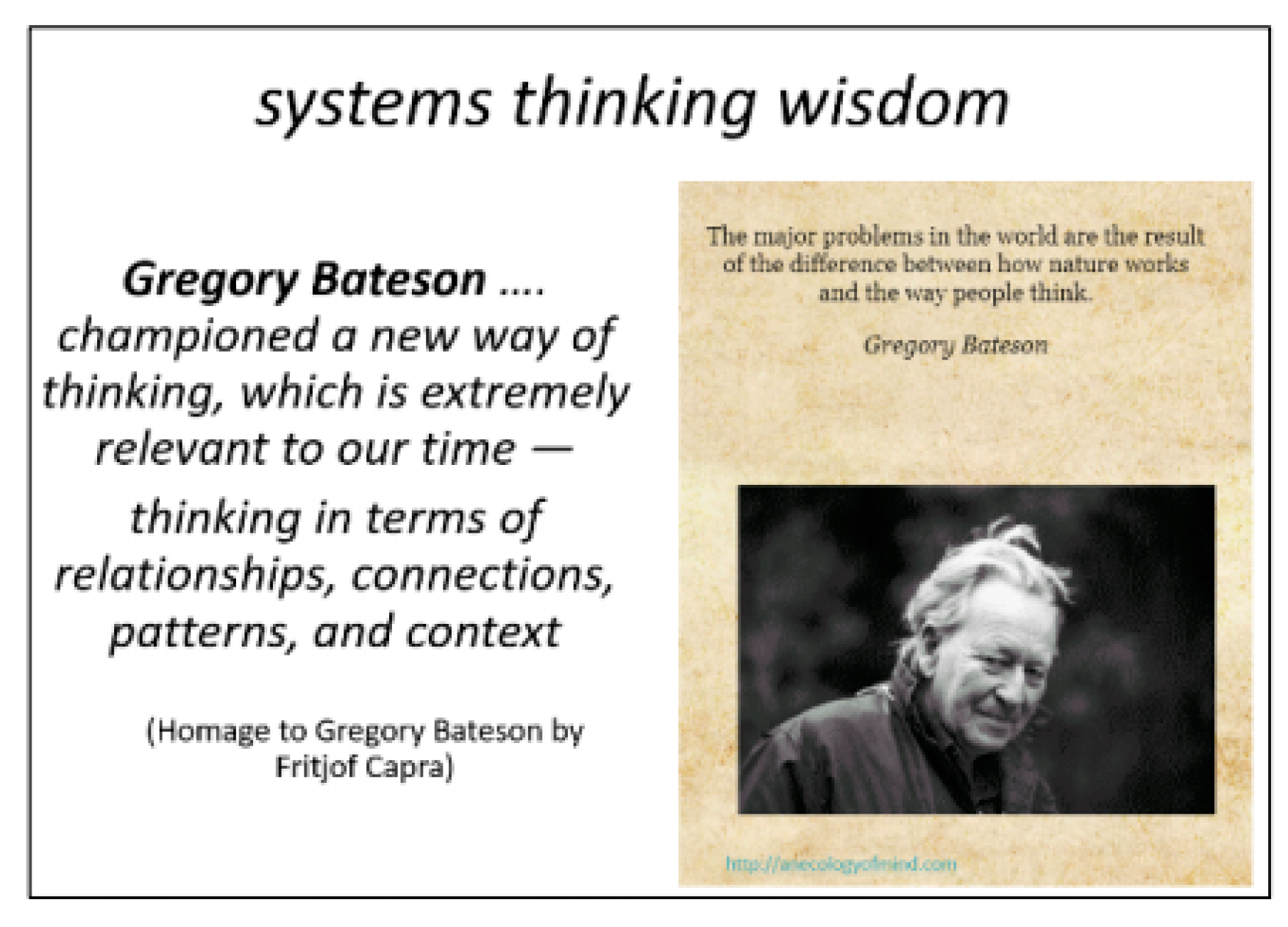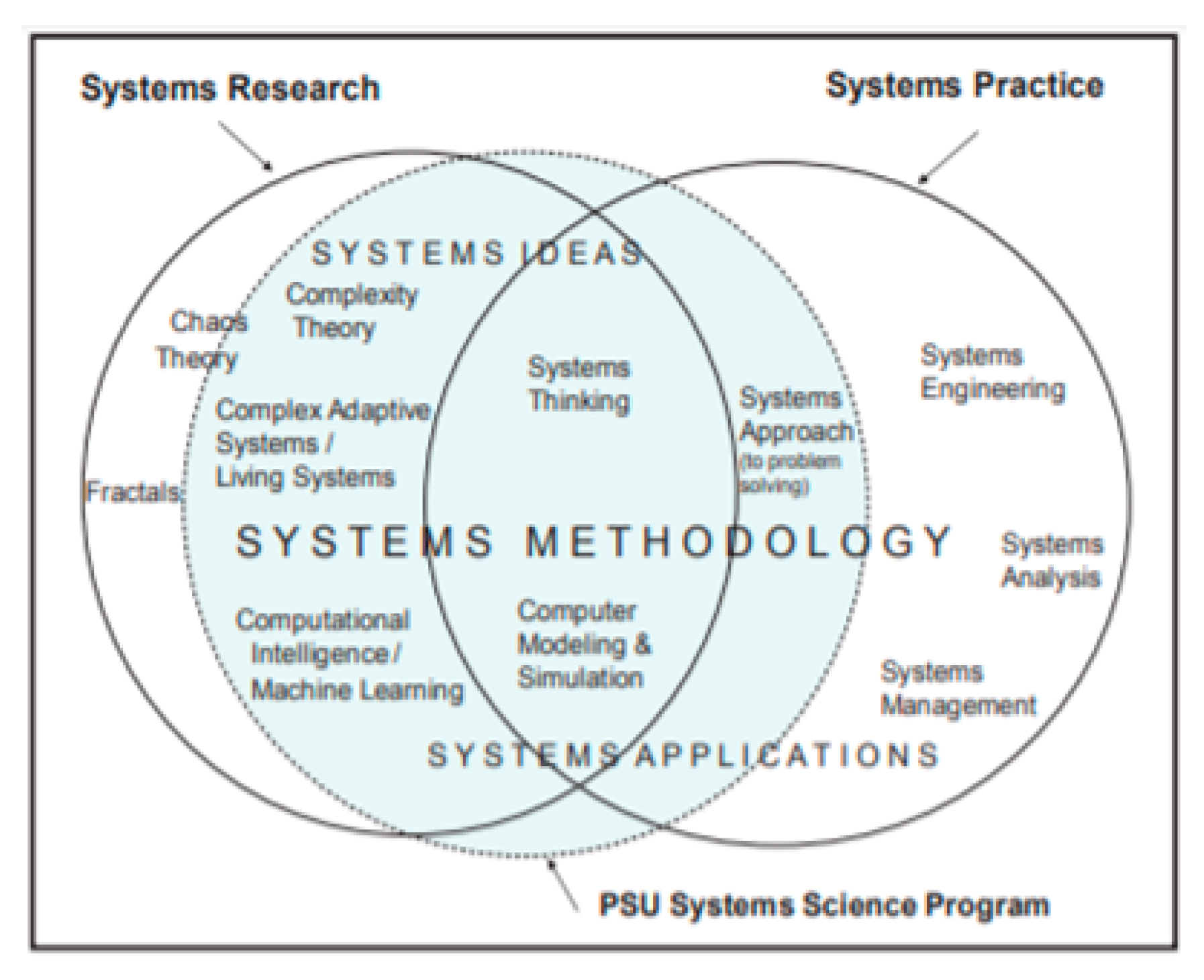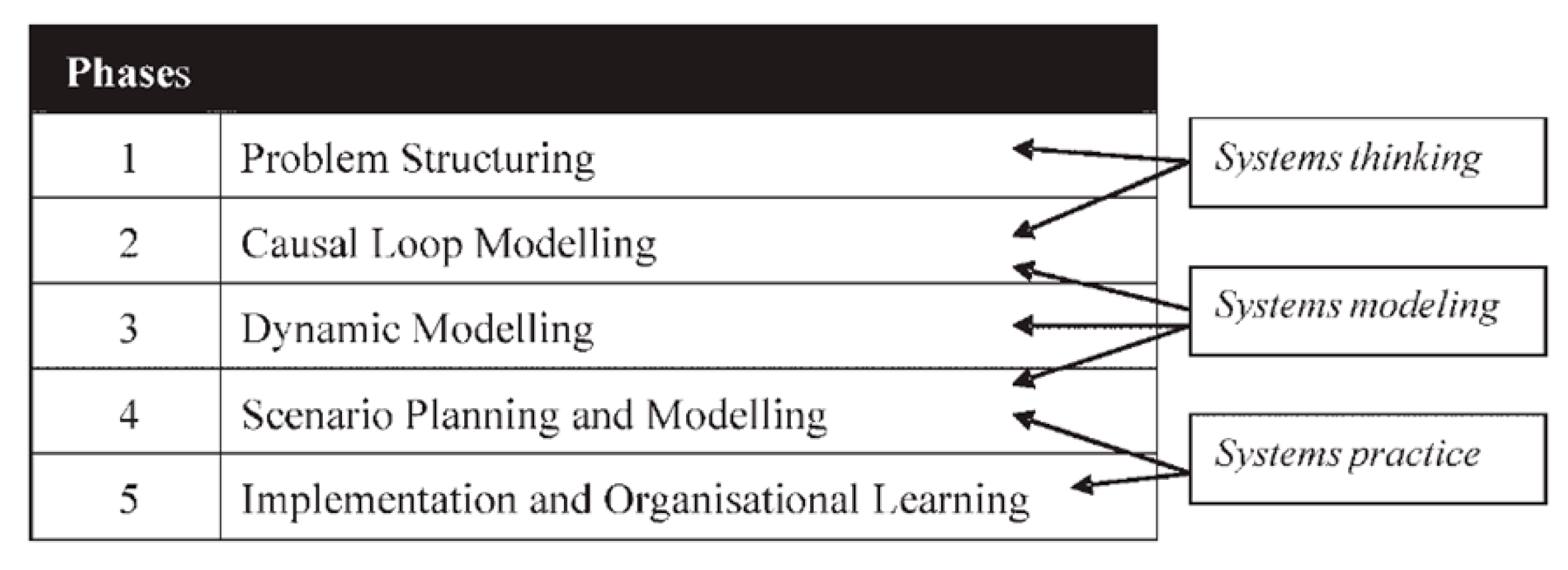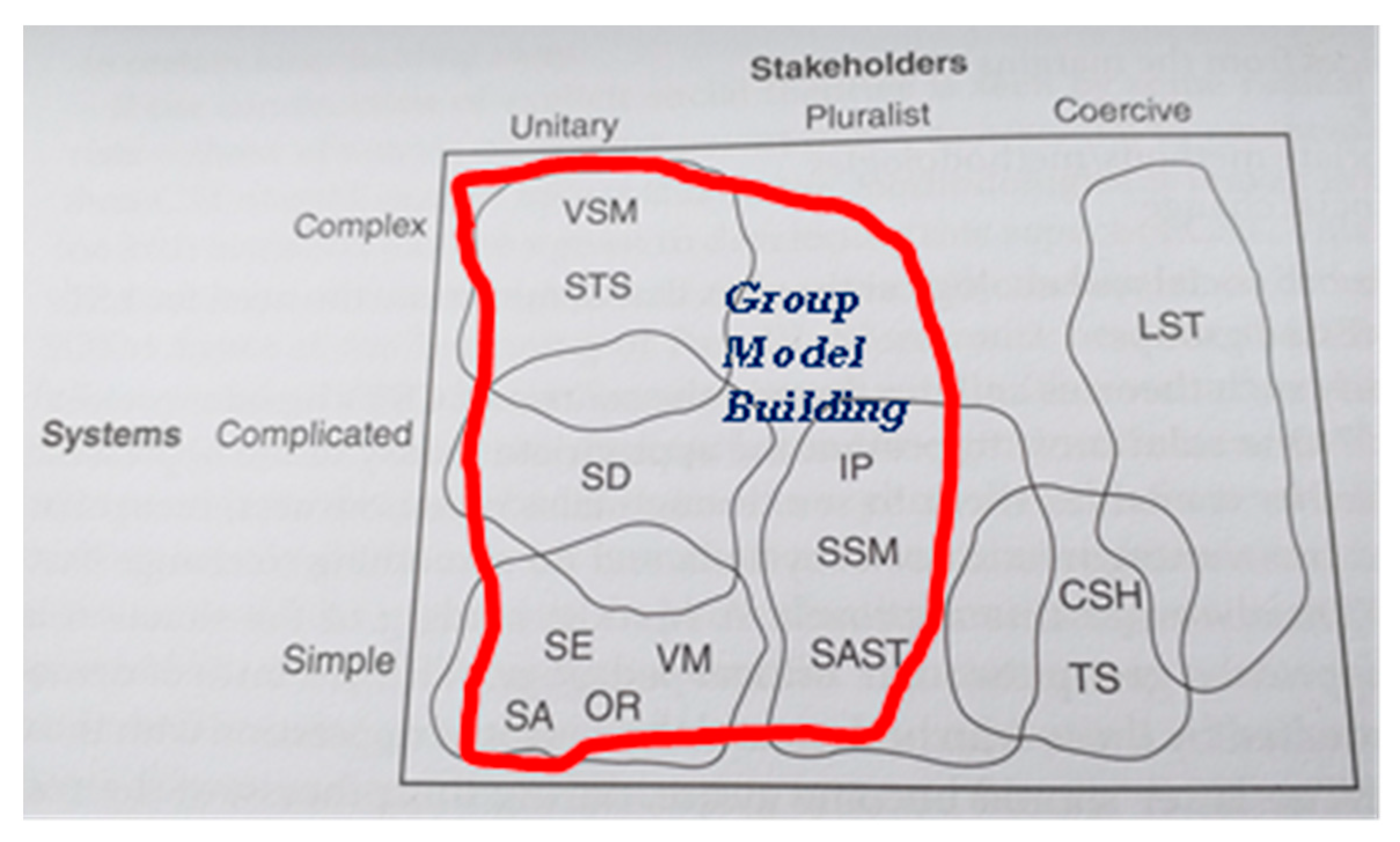1. Introduction
Systems thinking is an approach to reasoning and treatment of real-world problems based on the fundamental notion of ‘system.’ System here refers to a purposeful assembly of components. Thus, systems thinking is aimed at understanding relationships between components and their overall impact on system outcomes (i.e., intended and unintended) and how a system of interest similarly fits in the broader context of its environment.
There are currently several distinct flavors of systems thinking, both in practice and scholarship; most notably in the disciplines of systems science, systems engineering, and systems dynamics. Each of these, while similar in purpose, has a distinct history and a rich set of methods and tools for various application contexts. The WPI Systems Thinking Colloquium held on 2 October 2019 was aimed at exploring the diversity of perspectives in systems thinking from these disciplines. The colloquium brought together world-renowned experts from both industry and academia to share insights from their research and practice.
The experts were asked to give a thirty-minute presentation reflecting their definition of systems thinking. Many of the presenters addressed this request by discussing methodologies, insights for systems thinking in education, and systems modeling. To elucidate commonalities in the presentations, each was parsed for systems thinking concepts that were mentioned or discussed.
Figure 1 below is a Pareto chart that shows the number of speakers who mentioned the concepts listed.
For this chart, only concepts that were mentioned by more than one presenter are shown. The complete list of concepts collated are: Emergence, problems cannot be solved by technology alone, integrative thinking, soft systems modeling, hard systems modeling, scenario planning, organizational learning, information processing transactions, context, perspectives, holistic thinking perspectives (HTPs), well-structured problems, ill-structured problems, wicked and messy problems, out-of-the-box solutions, boundary of knowledge, volatility, uncertainty, ambiguity, complex adaptive systems, cognitive structures, bivalent logic, and multivalent logic.
Interestingly, several concepts that are mentioned in the literature were not mentioned at all by the presenters. These include the iceberg model, self-organization, oscillation, organized complexity, archetypes, and systemic root cause analysis. It is not clear whether these omissions represent a trend away from these concepts in the systems thinking universe or whether this is simply an artifact of the set of speakers. It is our hope that future colloquia will address this issue.
Subsequent sections of the paper offer a compilation of summaries of the presentations given. Each section title is followed by the presenter’s name. The full presentations and other conference materials can be accessed at the colloquium website [
1].
2. Systems Thinking a Catalyst for Purposeful Change by David Peter Stroh
There are systems thinkers who can benefit from understanding how to manage change, and change agents who can benefit from understanding the core principles and tools of systems thinking. This thought piece is intended to serve both groups.
Donella Meadows [
2] defines a system as an interconnected set of elements that is coherently organized in a way that achieves something. The vagueness of that last word signals a lot: While systems may be perfectly designed to achieve something, they are not necessarily designed to achieve what people most want them to. I believe then that systems thinking is the ability to understand these interconnections in such a way as to achieve a desired purpose.
Systems thinking helps leaders meet four challenges of change in ways that other change methods do not:
It helps meet the challenge of motivation by showing people how they unwittingly contribute to the very problem they are trying to solve and thus stimulating them to question their own intentions, thinking, and behavior.
It helps meet the challenge of collaboration by showing people how their actions not only impact others in the system but also impact themselves in unintended and often undesirable ways. Everyone is in the same boat, and therefore everyone needs to be responsible for redesigning the boat to be more functional.
It helps meet the challenge of focus by guiding people to target leverage points instead of leading them to assume that change occurs by doing as much as you can as fast as possible.
Finally, it helps meet the need for learning by directing people to continuously question their responsibility, however unintentional, for current reality.
The change process I developed with my long-time collaborator Michael Goodman builds on the creative tension model introduced by our colleague Peter Senge in
The Fifth Discipline [
3]. It guides leaders and other stakeholders through a four-stage change process, each with its own tasks as shown in
Figure 2 below:
Some recommended guidelines in using this process include:
Emphasize that developing a shared understanding of the current system and why it exists is the first step towards changing it.
Align stakeholders around a focusing question beginning with “Why?” such as “Why have we been unable to solve this problem despite our best efforts?”
Develop a diagram that maps an answer to this question, not “the system” overall.
Ensure that your systems analysis shows people how they contribute to the problem, tells recognizable human stories using everyday language, includes mental models driving specific cause-effect links, and integrates compassion for people’s experience of the problem with confrontation of their role in creating it.
Strengthen people’s commitment to change by challenging them to choose between the case for change (which tends to be more obvious) and the case for the status quo (which is less obvious but represents a key obstacle to change).
Ask additional questions that raise systems awareness such as:
- ○
If we know the solution, why haven’t we implemented it?
- ○
How might we be partly responsible, albeit unwittingly, for the problem?
- ○
What might be the unintended consequences of our proposed solutions?
What might we have to give up for the whole to succeed?
Finally, recognize that leading systems change requires more than just new cognitive capacities. It also requires emotional intelligence; the ability to engage people in uncovering the circles they are going in; and the development of character traits such as humility, curiosity, courage, and patience.
3. Systems Thinking the Elephant in the Room by Joseph E. Kasser
What is systems thinking? Let systems thinking be the elephant in the room because we do not really discuss but assume our own definitions of systems thinking and try and move on from there. Namely, the definition of systems thinking depends on who you ask or what you read. The multiple definitions can be grouped into two schools of thought summarized as systemic thinking and systematic thinking: Systemic thinking is about a system taken as a whole to gain an understanding of the system, not as a whole to be taken apart [
4]; systematic thinking is about employing a methodical step-by-step process to think about something or to achieve a goal. Using the elephant-in-the-room paradigm, the systemic thinking approach suggests that you need to be all the blind men in the room and combine the perceptions to gain an understanding of the system, whereas the systematic approach suggests that you use a process for that purpose. According to Gharajedaghi [
5], both systemic and systematic thinking are needed. Moreover, the perspectives you need depend on the problem, such as those I call the holistic thinking perspectives (HTPs).
The HTPs consist of nine external, internal, progressive and remaining perspectives. The external perspectives are the big picture and operational perspectives of the system. The internal perspectives are the functional and structural perspectives of the system. The progressive perspectives are generic, continuum, and temporal perspectives, and the remaining perspectives are the quantitative and scientific perspectives.
For example, consider a camera as the system of interest. Perceptions from the big picture perspective include where cameras are used, for what purpose, and various assumptions. Perceptions from the operational perspective include capturing images, transporting it safely, viewing images, adjusting settings, and charging the battery. Perceptions from the functional perspective include capturing images, storing images, retrieving images, deleting images, charging the battery, and so on. Perceptions from the structural perspective include the camera body, camera case, and battery charger. Perceptions from the generic perspective include painting, sketching, and other image capture methods or devices. Perceptions from the continuum perspective include different types and models of cameras, and different materials used to construct the camera. Perceptions from the temporal perspective include the evolution of the image capturing media from photographic plates to film to solid-state memory. Perceptions from the quantitative perspective include the number of pixels per inch, lens characteristics, and so on, and inferences from the scientific perspective depend on the problem or issue to be addressed.
Some of us use these perspectives all of the time, most of the time, some of the time, or none of the time. In the case of a camera, one person’s problem might be focused on understanding how a camera works, which needs perceptions from the functional and structural perspectives. Another problem might be focused on capturing images, which needs perceptions from the operational perspective, namely the camera and operator. Another problem might be focused on transporting the camera, which needs perceptions from the operational perspective, namely the camera, operator, and camera case. A fourth problem might be focused on recharging the camera battery, which also needs perceptions from the operational perspective, namely the camera, operator, and charger.
When perceiving the problem-solving process using the HTPs, two sequential problem-solving processes can be identified. The first problem-solving process starts with an undesirable situation and defines the problem, the second problem-solving process provides a solution.
One tool developed from the HTPs is a template for formulating problems using the following steps:
The undesirable situation—as perceived from the HTPs;
Assumptions—about the situation, problem, solution, constraints etc.;
The feasible conceptual future desirable situation (FCFDS)—as perceived from the descriptive HTPs;
The problem—how to convert the FCFDS to reality;
The solution:
- ○
Inferred from the Scientific HTPs;
- ○
Remedies the undesirable situation;
- ○
Has to be interoperable with evolving adjacent systems over the operational life of solution and adjacent systems (ideal);
- ○
Is made of two interdependent parts:
- ▪
The transition process;
- ▪
The solution system operating in the context of the desirable situation.
This problem formulation template can be used to help structure the formulation and solution to certain classes of problems. For example, if the existing undesired situation and the FCFDS are clearly identified, the problem is well-structured and may have a single solution or may have more than one acceptable solution. If either or both the existing undesired situation and the FCFDS are unclear, the problem is ill-structured and cannot be solved [
6] and must be converted to one or more well-structured problems. Extremely ill-structured problems, such as wicked and messy problems, cannot be solved [
6] and must be converted to well-structured problems. Perceptions from the generic HTP note that problems with unpredictable non-deterministic outcomes, characteristic of wicked problem are those that appear in the first state in the scientific method, namely a lack of understanding of something which is beyond the current body of knowledge. Recognition of this perception may stimulate out-of-the-box solutions.
3.1. Finding Out-of-the-Box Solutions
How can this approach to problem-solving be used to find out-of-the-box solutions? Using the scientific method and the problem formulation template:
The undesirable situation—the need to find an out-of-the-box solution;
Assumptions (innovative idea)—everyone is working in a box;
The FCFDS—an out-of-the-box solution has been found;
The problem—how to convert the FCFDS to reality;
The solution—is based on a hypothesis; an out-of-the-box solution in one box comes from a solution to the same/similar problem in another box (generic HTP) in a similar manner to TRIZ, which can be addressed by the following:
Consider two boxes which might contain out-of-the box solutions to problems in a different box. The Hitchins-Kasser-Massie framework (HKMF) [
7] contains a set of boxes by considering the various phases of the system life cycle and layers of the systems engineering hierarchy, as depicted in
Figure 3 from Kasser and Massie [
7]. If the current box is positioned in the framework, how the problem is dealt with in boxes in the same row or column may provide a solution to the problem in the current box.
3.2. Solving Complex Problems
There are two schools of thought in how to solve complex problems. One group proposes the need to develop new tools and techniques to solve complex problems, while the other group believes that complex problems are being remedied successfully. Using the continuum HTP in forming the hypothesis provides a powerful tool in observing that there may be more than one reason or cause for this dichotomy. After 20 years of conducting the research outlined above, eight different perspectives were identified as a combination of causes, which are summarized in
Figure 4.
If one looks for a single correct solution to a complex problem, then one will probably be unsuccessful. However, if one looks for an acceptable solution among several potential solutions, then one is more likely to be successful. If one is confusing ill-structured problems with complexity, then one will be unsuccessful. However, if one is trying to solve well-structured problems, then one can be successful.
Regarding the boundary of knowledge, complexity has always been at the boundary of knowledge. Perceptions from the temporal HTP note that, over time as problems we have faced have become more complex, their solutions have always followed the boundary of knowledge at that particular point in time. For example, taking an example from Rumsfeld [
8], as illustrated in
Figure 5.
The green area depicts the knowledge that we know we know, which has deterministic outcomes. Complex problems that lie within that green area can be addressed successfully, as long as one uses the proper perspectives. Complex problems that lie just above the boundary of knowledge in the yellow area, namely knowledge that we know we don’t know, can be addressed through research using the scientific method. One example of such a problem was the manned space problem of successfully getting a man to the Moon and back. Complex problems that lie in the red area, namely knowledge that we do not know we do not know have non-deterministic outcomes and cannot be addressed successfully. The only way to address those problems is to conduct research to move the green area into the yellow area, which advances the yellow area into the red area.
In conclusion, teaching systems thinking requires a different paradigm to find out-of-the-box solutions to complex problems.
4. Distinction, System, Relationship & Perspective- DSRP Is Universal to Systems Thinking by Derek Cabrera and Laura Cabrera
4.1. VUCA World—Volatility Uncertainty, Complexity, Ambiquity
Developed in the military to characterize conflicts in the post-Cold War era, VUCA is an acronym denoting a context characterized by volatility, uncertainty, complexity, and ambiguity. The term is used by strategists and in managerial circles, and is readily applied across different levels of scale. Advances in technology and communications and the globalization of an increasing array of phenomena mean we all live in a VUCA world. Volatility, uncertainty, complexity, and ambiguity are all different phenomena, but together they necessitate a new approach to organization, problem solving, and planning. The fourth wave of systems thinking includes: A new logic (bivalent nested in multivalent); focus on simple rules to deal with complexity; universality and content agnosticism; and a focus on metacognition for deeper understanding and emotional intelligence, all of which enable us to tackle VUCA head-on.
4.2. Reality Bias
A mental model is our understanding of the world—an approximation of reality based upon our ideas, beliefs, and past experiences. “Reality bias” refers to our belief that we experience reality directly. Instead, we perceive the real world indirectly through mental models—unique filters that highlight some things, ignore others, and add interpretations. If we notice when our models do not conform to reality, we can use that discrepancy to improve them. This feedback cycle represents the learning process. Mental models shape our understanding of everything around us—from simple to wildly complex phenomena. Our understandings in turn shape our behavior, generating real-life consequences.
Figure 6 illustrates this relationship between our mental models and the real world.
4.3. The Fourth Wave
The field of systems thinking is widely applied across the physical, natural, and social sciences and the public and private sectors. Scholars in the field recognize four historical waves.
Figure 7 depicts the waves and a sample of associated methods, theories, and approaches. While the first three waves differ in terms of philosophical approach, associated theories, and methods, the fourth represents a simultaneous simplification and unification of the field, making systems thinking more accessible to specialist and novice alike.
The first wave included “hard,” expert, or technical systems, and mostly quantitative methodologies. The second wave of systems thinkers reacted to what they perceived as a failure to account for the wider social context and the participation of multiple, diverse stakeholders, and focused more on qualitative methods, collaboration, and facilitation. The third wave criticized this paradigm war and emphasized methodological pluralism while adding consideration of power relations. This pluralism has had the unfortunate side effect of “silofication” of the field into subspecialties. This diversity makes it difficult for newcomers to grasp the field and for seasoned scholars and practitioners to move the field forward.
An emerging fourth wave of systems thinking unifies and advances the field by identifying the DSRP as underlying the diversity of the three waves. Incorporating the modern cognitive sciences, the fourth wave arose from the discovery that systems thinking is a Complex Adaptive System (CAS), an emergent property of DSRP patterns.
4.4. Complex Adaptive Systems and Simple Rules
Complex adaptive systems (CAS) are bottom-up phenomena in which individual “agents” follow simple rules that lead to complex, macro-level outcomes called emergent properties. The agents of a CAS could be organisms, people, organizations, economies, etc. A CAS adapts to survive in its environment. To understand the complexity that emerges in a CAS, we need to discover the simple rules that govern the micro-level behavior of its constituent parts. In many CAS there is no leader or leadership. There are many examples of complex adaptive systems (CAS) in nature, such as ant colonies, and large flocks of birds or schools of fish that move quickly in perfect unison. Humans themselves often constitute complex adaptive systems, in that their simple actions can generate incredible complexity. The human brain is a CAS. Systems thinking is also a CAS, an outcome that emerges from application of four simple rules: Making distinctions and recognizing systems, relationships, and perspectives (DSRP).
4.5. See More
How can we avoid the costly problem of constantly reacting to events? The first three waves of systems thinking encourage us to think deeper. First, to identify the patterns underlying systems so that we can anticipate or predict events. Next, to seek out systems’ structural properties, enabling us to design systems to produce desired outcomes since “system structure determines behavior.” Then, to understand the significance of mental models. The fourth wave delves into the cognitive structure of mental models, showing us the four patterns underlying all thought, this is depicted in
Figure 8. Applying DSRP allows us to recognize the pervasiveness of mental models so we can deconstruct them. It expands our thinking by identifying new perspectives to take and yet-to-be-made distinctions, systems, and relationships. In this way, the fourth wave achieves a newfound balance between both the systems and the thinking aspects of systems thinking.
4.6. A Universal Code
Dr. Derek Cabrera identified four simple rules (or patterns) that underlie the multiple approaches and methods that characterize the field of systems thinking. These rules are making distinctions and recognizing systems, relationships, and perspectives (DSRP). As the building blocks of human cognition, they form a universal cognitive code. Each rule consists of two co-implying elements. This means that the existence of one element implies the existence of the other (e.g., for the systems rule, a part implies the existence of a whole and vice versa). While we treat each rule separately to facilitate understanding, in reality the four rules operate simultaneously and in no particular order. Neither D, S, R, nor P exists in isolation. For example, recognizing a system of parts, or the relationships among those parts, or a perspective, all entail making distinctions. So too, a single relationship can be a whole system made up of parts.
Figure 9 lists the DSRP rules and elements.
4.6.1. Distinctions Identity-Other
One of the rules of DSRP is making distinctions. It is innate for humans to distinguish one thing from another—what is variable is how conscious we are of this process. Distinctions consist of two co-implying elements: The identity (the thing or idea that is the focus of attention) and the other (that which is not the identity). Distinction-making consists of defining what the problem/issue/thing is, and what it is not, which is an act of boundary making that entails opportunity costs—a critical idea in systems thinking. When you engage in conscious, systematic application of the distinctions rule, you can increase the clarity and precision of your thinking, eliminate redundancy, and promote awareness of perspective (since what we focus on is always a matter of perspective). On the other hand, unconscious distinction making can lead to marginalizing the other and lack of awareness of the sources and the consequences of our boundary making.
4.6.2. Systems Part-Whole
The systems rule—any idea or thing can be split into parts or lumped into a whole—consists of two co-implying elements: Part and whole. Applying this rule simultaneously incorporates reductionism (splitting things into their constituent parts) and holism (seeing everything as part of a larger whole). When we apply the systems rule, we recognize that what is a part of one whole can also be a whole in itself composed of different parts. We also are mindful that the way we organize parts into wholes is influenced by perspective and can change the characteristics of the system.
4.6.3. Relationships Action-Reaction
Relationships are a central focus in systems thinking (e.g., the idea of feedback loops). The relationships rule—any idea or thing can be related to any other idea or thing—is characterized by two elements: Action and reaction. When problem solving, we often look for relationships of correlation, some of which may involve cause and effect. Systems thinking often emphasizes the complexity of relationships, seeking out webs of causality rather than single, linear causes. Thorough application of the relationships rule entails identifying the relationship. Since they are often the hidden dynamics of systems, identifying the relationships among parts is critical to systems thinking.
4.6.4. Perspectives Point-View
Perspectives are integral to the systems thinking concept of mental models. The perspectives rule states that anything or idea can be the point or a view of a perspective. This rule entails two elements: A point (that which is being focused upon or seen) and a view (that which is doing the seeing or focusing). Conscious application of the perspectives rule requires that we acknowledge that what we perceive as reality is really a mental model—just one of many ways to frame information—and proceed to identify the perspective(s) that make up that model. Perspective taking is entailed in every distinction we make and every system and relationship we identify. The ability to identify the perspectives implicit in all information we encounter—and to consider and apply alternative perspectives—is a tremendous aid in problem solving and consensus building. In other words, we need to look at how we and others frame issues, consciously or unknowingly. When we change the way we look at things, the things we look at change.
4.7. A New Logic
Systems thinking entails the application of logic, or often unconscious guiding principles. Bivalent logic entails “either/or,” dichotomous, “black and white” thinking (e.g., right vs. wrong). While easy to apply, bivalent logic is often inadequate to understand the complexity of the real world. Multivalent logic recognizes multiple outcomes and nuance (“shades of grey” rather than black and white) and is conducive to systems thinking. DSRP allows for a new, “both/and” logic that situates bivalent logic within a multivalent frame. Making distinctions is a bivalent act (identity vs. other), but that distinction making occurs simultaneously with application of the relationships, systems, and perspectives rules.
4.8. Information + Structure
We construct mental models (i.e., meaning, knowledge, concepts, ideas) from information and structure. To illustrate this concept, consider language, where information is represented by words. However, the way we structure these words—using mechanics (punctuation) and syntax (which includes word order)—can give different meaning to the same set of words. Consider this example: “Woman without her man is helpless.” And, “Woman, without her, man is helpless.” Structured through differing use of punctuation and syntax, the same set of words can produce entirely different understandings or mental models. In systems thinking, information includes words, numbers, symbols, images, and data. Structure is the underlying cognitive patterns: Making distinctions and recognizing systems, relationships, and perspectives (DSRP). Becoming a systems thinker entails seeing both the information and the structure. The real promise of systems thinking lies in its utility for addressing transdisciplinary “wicked problems”: seemingly intractable, complex issues that involve competing interests and multiple systems (e.g., economic, social, political).
4.9. Systems Mapping
Systems thinkers often use visual models because they convey the complexity of systems. All mental models (i.e., concepts, ideas, etc.) are made of information (data) and DSRP structure that are easily depicted in two-dimensional maps shown below. These maps are content agnostic and can be as simple or complex as the user requires. Every node in a DSRP diagram can be a distinction (an identity or another), system (a part or a whole), relationship (an action or reaction), or perspective (a point or a view). This is illustrated in
Figure 10. ThinkBlocks are 3-D, dry-erasable, nested, relational, and perspectival blocks that help people do systems thinking in groups, using their hands to move ideas around to build shared systems models and understanding.
These tools activate the underlying rules of systems thinking that can be applied to any issue or concern by facilitating distinction making, organizing systems of parts, making relationships between parts (and systems), and altering all of the former based on different perspectives.
5. Reflections on Systems Thinking by Donna H. Rhodes
Systems thinking is such a vast topic that has long been studied and discussed, resulting in a large body of knowledge from multiple fields and disciplines. Yet, I believe there has never been a greater need to re-examine this topic in context of our contemporary world. I share some personal reflections on systems thinking that I hope will contribute to the ongoing dialogue.
My personal worldview that informs this discussion emerges from a number of different experiences. The first of these was my study and early career in anthropology and archaeology. I later went back to graduate school at Binghamton University (then SUNY Binghamton), one of the great centers of systems science and general systems theory [
9]. One of my mentors was George Klir, a pioneer in systems science and general systems theory. My primary mentor was Walter Lowen, founding dean and professor at Binghamton, who went from a career in nuclear engineering to systems science, especially human systems science. Over the years, we continued to collaborate in investigating and teaching systems thinking in both academia and industry. After spending the first half of my career in industry in systems engineering, I went to MIT where I found an intellectual home in engineering systems.
5.1. Awakening and Awareness
I imagine most of us have asked the question “what is systems thinking?” and “how do I observe it?” But have you asked yourself how it awakened in you, how it awakens in others? One of the things Walter Lowen taught me was that children and grandchildren make wonderful subjects to observe. The picture below (i.e.
Figure 11) is my grandson, Nathan, when he was four years old. We were sitting outside and there was a pile of wood, so I said “Nathan, why don’t you try to build a building”… so he went over and built one, knocked it down, built another and knocked it down. After a third time, I heard him say to himself “this is boring.” He stood up and looked around. Like many kids at this age, he was at the time very interested in black holes, so he built this structure. At that time, he had actually never seen or touched a telescope, though we had talked about them and looked at pictures.
If you look just at the picture you might think this was design thinking. He had this quest to understand black holes, so this is what I think prompted him. He had something he wanted to understand, and it opened up when he thought about the context. He looked up, he saw the world around him and in that context constructed this, then spent quite a bit of time looking through his telescope seeking to gain some understanding.
So, the question I would pose around this is can we observe systems thinking? And, with an experience like this I almost think we need to know the systems thinker. Unless I understood what was going on in this little guy’s mind, I might not recognize this as systems thinking. Seeing him and knowing him so well … seeing a switch flip, “oh there is a world out there, I can do something with that.” This is a key question: How does systems thinking awaken?
5.2. Reference Experiences
Another thing I think is very important, and I’ve thought a lot about in recent years as I get older, is the importance of reference experiences. I got involved in archaeology when I was twelve years old, spending two summers working with a team to excavate a very rich archaeological site. There were many layers, many cultures, and many grids where people were digging, so you could really start to see the relationships, cultural indicators, and patterns of where things came from in the world. This experience was an underpinning for my understanding—there is system, there is a context, there are relationships, and all these interesting dimensions to think about. I still reflect on many of the constructs I learned during that time. But, as I later went on to college, I went to an academic archaeology field school, where students learn practical approaches and all sorts of tools—but it was really kind of mechanistic. That can be a problem sometimes in the classroom, so how do we bring this holistic thinking back alive?
5.3. A Systems Education
After my work in archaeology, my return to graduate school at Binghamton University to study systems science turned out to be a whole new awakening for me. One of the most popular courses at Binghamton, developed and taught by a brilliant professor Don Gause, was called heuristic problem solving. Almost everyone who studied systems science at Binghamton in that time period names this as the course that has most influenced their mindset—that woke them to systems thinking. Students were faced with solving seemingly impossible problems, but it was really about systems understanding. It is difficult to describe the true learning experiences in that class; one was a fundamental understanding of context versus context-free. To this day, there are elements of that course that inform my views on systems education. Jerry Weinberg [
10], a visiting faculty member there, believed “a system is a way of looking at the world.” His book on an introduction to general systems thinking includes testimonials on how education can lead to systems understanding. An example of this is shown in
Figure 12. I think it’s rare to find the same kind of education today, as the outcomes are difficult to measure and the value is rather implicit.
5.4. Empirical Findings
I don’t think we study systems thinking enough in our field, especially the pathways for how it happens [
11]. While at MIT, Heidi Davidz [
12] performed doctoral research on the development of engineering systems thinking, and found experiential learning to be one of the key factors. This included the influence of people’s early life experiences in systems-like thinking. One of the findings from her analysis was that 71% of junior engineers did not understand how their organizations define and measure systems thinking. Organizations want their engineers to become systems thinkers but don’t define what this capability means. Caroline Lamb [
13], in her subsequent doctoral studies investigated collaborative systems thinking. She found that teams could be capable of systems thinking outcomes, even if every team member was not perceived to be a systems thinker. While exploratory, this has implications for education—how do we in a classroom setting foster group systems thinking in projects, while ensuring we enhance each individual’s capacity for systems thinking?
5.5. Systems Thinking Capacity
Systems thinkers do not all think alike. My mentor, Walter Lowen, wrote a book entitled
Dichotomies of the Mind [
14], that was inspired by his observations of his two sons—one of these he could perfectly understand and the other he could not, or as he said this son was “an unfathomable wonder to me.” This inspired his interest in developing a systems model of the mind. This work, largely grounded in Jungian typology, looks at 16 types of transactions in the processing of information. The model is a concept model, not intended to be a model of the brain. There are certain transactions our minds are capable of and the pathways we each take are different. So, if we acknowledge there are different ways of thinking, such a model can help us understand how to enhance systems thinking capacity, but through an approach that is not “one size fits all.” Accordingly, perhaps for one individual, classroom activities or lectures are effective, while for another it might be that game-based learning is more effective.
5.6. On Teaching about Systems
I teach a course at MIT, systems architecting applied to enterprises. Most of the students come from professional backgrounds and have taken systems courses on systems engineering, systems architecting, and project management. Many of the students tell me that my course is the one that brings it all together for them, that makes it click. In prior classes they learn theory, constructs, and techniques so this gives me the luxury of building on this knowledge. Students do team projects on a selected enterprise, involving holistic thinking about structures and relationships within an embedded context (ecosystem). Systems learning emerges from the thinking about parts and wholes, and experiential learning of principles such as adaptive capacity and requisite variety. The open question is, how do we combine all these things to make a powerful learning experience for both teams and the individual students? And while these students often are not so interested in theory, I think we can teach from a theoretical perspective through principles-based learning.
5.7. Challenges of Systems Thinking Education
There are many challenges of systems thinking education, including how we awaken and engage the systems thinker, and enhance the awareness of system contexts. We are faced with having to teach the “building block” techniques, but how can we do this in a manner that does not create mechanistic mindset? And, how do we measure the capacity for systems thinking, especially when we acknowledge that systems thinkers have different thinking pathways and learning preferences? I think these are all good research questions. These challenges are summarized in
Figure 13.
5.8. Imperative for New Dialogue
I believe there is an imperative for a new dialogue on systems thinking. Some of the driving forces are complexity of systems contexts, volume and intensity of interrelationships in systems, and the velocity of systems knowledge that we are experiencing today. And, we need to expand our focus beyond the systems thinker, to the potential of systems thinkers having augmented intelligence capabilities.
As I reflected on my personal views of systems thinking, I considered whether I should express a definition of systems thinking. Instead, I offer a glimpse of systems wisdom from Gregory Bateson [
15] (
Figure 14), who has long been an influence on my worldview and beliefs. There is so much wisdom that has been generated that can inform a contemporary understanding of systems thinking. I believe this can be re-framed in context of our world today and the systems we wish to understand and evolve. Then, we can bring this forward into the education of systems thinkers.
6. Why Systems Thinking Is Not a Natural Act by Ricardo Valerdi
It is important to ask: When is systems thinking natural and when is it not? Evidence suggests that most people do not possess the innate ability to think systemically. This section provides some possible explanations for this and solutions to consider.
The first reason systems thinking is not a natural act is because human evolution has favored mechanisms tuned to dealing with immediate surface features of problems—Jared Diamond’s book,
Collapse [
16], provides numerous examples of the downside of these “programmed” human tendencies and how they can lead to the downfall of societies. For example, the people on Easter Island did not realize that the root systems of the trees they were cutting down provided the means for capturing rainwater that enabled them to grow crops on an island with little if any soil. Once the trees were gone—all used up to roll statues from the quarries to the coast—they could not grow crops anymore and starved.
A second explanation for the lack of systems thinking is bounded rationality [
17]: The complexity of the systems we are called upon to manage overwhelms our cognitive capabilities. Some complex systems are beyond human ability to comprehend, which lead to a natural reductionist reaction that works against the competencies discussed earlier. A related cause is over-specialization. Workers with job functions that have a narrow focus or are based on highly specialized tasks are naturally inclined to have a limited view of the system. This makes it more difficult for them to step back and exercise the competencies referred to earlier. An associated reason that inhibits systems thinking is having a short time horizon. Workers with a constrained view of the system do not have the incentive to apply systems thinking.
A third explanation for the lack of systems thinking is the set of institutional constraints in rigid, hierarchical organizations. Organizations that are required to follow strict command and control protocols such as the military, or highly bureaucratic environments such as the federal government, are not good candidates for systems thinking.
The challenge with systems thinking is that emphasis is often placed on mechanistic/reductionist approaches in decision making. From a young age, students ask insightful questions and are curious about why things happen. However, elementary school curricula are too rigid because they are structured around finding the answer without exploring possibilities. This is also due to teaching memorization rather than problem solving and overemphasis on standardized testing, in part because such tests are easier to grade and believed to be reliable measures of student performance.
The question that follows is:
Are systems thinkers born or made? In general, intuition works well in frequent and familiar situations; it often fails in situations that are infrequent and unfamiliar due to the strong tendency to map unfamiliar cues to familiar situations that subsequently prompts an inappropriate response. Studies suggest that systems thinkers can be developed through experiential learning [
12] and coaching [
18]. These examples of systems thinking interventions illustrate their ability to alter thinking, behavior, and results as shown in
Table 1.
Systems thinking could also be developed via games or flight simulators as is done in other disciplines such as aviation and operant conditioning. The case method could also be instructive, such as used at Harvard and Wharton Business Schools. In the end, we need more efficient and effective ways to develop systems thinkers in order to prevent some of the system failures that have resulted in financial, technical, and societal losses.
7. Systems Thinking an Economist’s Perspectives by Mike Radzicki
There are two key concepts in systems thinking. The first is that a system’s structure causes its behavior and the second is that to understand its behavior a system’s structure must be studied holistically. The latter concept implies that a system’s constituent parts and their interactions must be studied together, as a whole, rather than as individual entities to be examined in isolation, and whose behaviors are simply summed up to identify system-wide dynamics.
Importantly, to a large degree, impactful leaders are systems thinkers. For example, many prominent thinkers of the Enlightenment era in general, and key authors of the U.S. Constitution in particular, were systems thinkers. Thomas Paine, with his pamphlet
Common Sense, helped to shift the public’s focus from events (Lexington and Concord), persons (King George), and policies (taxation without representation) to a new system of government [
24]. Similarly, great writers, novelists, and storytellers are systems thinkers. Leo Tolstoy’s
War and Peace, for example, is chocked full of systems thinking concepts [
25]. Great leaders in team sports (e.g., point guards, quarterbacks) are also frequently systems thinkers as they are said to be able to “see the whole court” or quickly “read the defense” and adjust things on the fly. Finally, consider the military. The bottom of the hierarchy is populated by “specs”—i.e., “specialists” while the top of the hierarchy is populated by “generalists”—i.e., “generals”. Generals need to survey the entire battlefield and think through the interactions of the infantry, cavalry, artillery, medical corps, supply lines, etc., as well as the likely actions and reactions of the enemy.
Although impactful leaders frequently think holistically, they suffer, as do all humans, from an inability to accurately think through the implications over time of their own mental models. In other words, the human mind is a poor dynamic simulator. As a consequence, dynamic simulation tools are necessary for impactful leaders to take complete advantage of their systems thinking perspectives. This leads to a third key concept in systems thinking: The principle of accumulation, which states that all dynamic behavior in the world occurs when flows accumulate in stocks. To become masters of systems thinking, impactful leaders need tools that can be used to map-out their mental models with networks of interconnected stocks and flows and then reveal, via simulation, the dynamic behaviors inherent in their structures. Happily, tools such as system dynamics modeling can be used for precisely this purpose [
26].
In economics there are many different schools of thought. Although they can be categorized in a variety of ways, one approach for classifying them involves utilizing their method of explanation. At the risk of oversimplification, there are two main methods of explanation employed in economics. Orthodox economists employ the deductive covering law model of explanation, which involves deductive logic and deriving testable hypotheses (i.e., econometrically estimable equations) from fundamental laws and antecedent conditions (i.e., from economic theory). The approach is top-down or from the general to the specific: Theory and logic come first; an examination of the real world occurs second.
Heterodox economists, on the other hand, utilize the pattern modeling approach to explanation, which involves inductive logic, empiricism, and the case study method [
27]. In pattern modeling, an economist “detective” tries to piece together an explanation for what has happened (i.e., a pattern) from all of the “clues” at the “scene of a crime.” The metaphor is a puzzle whose pieces have been scattered around the floor. Any similarities among “crime scenes” are collected by the economist detective into a set of “real typologies,” and any similarities among real typologies are identified as “principles of economic systems” [
28,
29]. The economist detective utilizes knowledge of real typologies and principles of economic systems as an aid to assembling a pattern model at the next crime scene. This approach is bottom-up or from the specific to the general: An examination of the real world occurs first, followed by the assembly of economic principles and theory second.
Of note is that system dynamics modeling follows the pattern modeling process. System dynamics models are pattern models. Similarities among system dynamics models are known as generic structures and similarities among generic structures are known as principles of systems, the most important of which is the principle of accumulation. System dynamics modelers utilize principle of systems and generic structures to model the next problem with which they are presented.
In sum, heterodox economists are systems thinkers and they can exhibit impactful leadership by translating their economic pattern models into their equivalent system dynamics representations, simulating their implications, and redesigning their structures for improved behavior.
8. My Take on Systems Dynamics by Khalid Saeed
I first encountered the term system dynamics in my undergraduate studies in electrical engineering. It concerned the behavior of innate mechanism with characteristic problems like steady state error, instability, and sluggish adjustment. The control process created feedback mechanisms driven by the functions of the error to overcome those problems. I was fascinated when I rediscovered the term system dynamics in a course on operations research, this time in the context of human systems. It showed me how to represent invisible relationships that drive decisions in organizations and create an experimental process to find ways to overcome problematic behavior. Created by a control engineer, Jay Forrester who is credited with inventions like random-access memory and some of the earliest computing systems, system dynamics embodied an alternative approach to calculus that could be applied to behavioral and organizational sciences and economics.
So, what exactly is system dynamics? I had an occasion to conduct a public interview with Jay Forrester in 2013. He was 95 then. My closing question in this interview was: Jay, what do you think you’ll be known for in about 20 years?
Forrester surprisingly did not talk about his ground-shaking work in computers. Here are the highlights of his response:
So, I would like to be known for having thrown out differential equations in all fields. This is not going to be over the next 50 years.
And, I would like to be known for having completely replaced economics, and that’s not going to be in 25 years either.
There are a few others, but that’s enough for now.
Trying to understand the meaning of these statements has been a long journey for me that involved many conversations with Forrester which led to two articles [
30,
31]. At the outset, I’d like to say that the first two statements are related and that many economists share the disdain expressed in the second. The third possibly alluded to the occasional happenstances that involved Forrester in addressing a multiplicity of problems.
First, about the differential equations: A derivative is an ex post computation of historical experience. Thus, a differential equation cannot be compared with the related system in the real world. On the other hand, since reality integrates over time, a logic that captures this integration process can be easily discerned from reality and also compared to it. However, if we were to replace the differential calculus with a process that replicated integration over time, the computational detail of it would be very tedious and you would definitely need a digital computer to carry out the integration in the system so surmised. Digital computers of course did not exist when the elegant art of calculus was created. Now that we have computers that can perform the tedious computations, why not adopt a realistic integration format that can be verified and also intuitively understood?
Forrester devised the bathtub–faucet–drain representation that we have adopted in system dynamics. This representation can be inferred from reality and the models created in it compared to the real constructs and thus verified. Also, our explanatory tool—the feedback loops—are an integral part of this representation. This takes the guessing game out of our explanations of the model behavior. Forrester’s bathtubs and faucets are an intuitive way of representing calculus that is the cornerstone of system dynamics, and he highlighted this as his legacy.
Second, about economics: Although economics started as a descriptive theory, we started representing it using differential calculus and since verification of differential equations is difficult, the verification process was really dispensed with. The abstract models created with calculus gave birth to the concept of rational agency that underpins modern theory. Albeit, the world is run by managers, not rational agents. Manager, an agent in a bounded rational role is the actor in Forrester’s work on economic issues. He aspired to replace rational agency-based economics with manager-based economics. A version of economics that managers can relate to, understand and practice.
Forrester’s book
Industrial Dynamics [
32] in fact presents a manager-based theory of firms and his unpublished national model presents a model of the macroeconomic system as an extension of his model of a firm, since an economy is an aggregate of firms. In these models, the decisions are made by down-to-earth managers who might be trying to balance everyday firm operations like maintaining reasonable levels of inventory and workforce to produce quantities needed for meeting incoming orders. Other managers try to balance production capacity with their perception of what is needed. Problems of inability to meet goals (steady state error), overshoot, instability, and sluggishness in adjustment arise out of the interaction of the bounded rational policies the managers follow. In fact, that is how classical economics described the working of the economy.
Third, about other things, Forrester was interested in applying his approach to a variety of economic and social problems and dealt with them as opportunities arose. He called these opportunities happenstances and his contributions to normative economics—‘Urban Dynamics’ [
33] (an operational framework for economic development) and
World Dynamics [
34] (an operational framework for environmental economics)—arose out of such happenstances.
So, here is my take on what is system dynamics:
An alternative calculus that is intuitive and can be implemented on modern computers—models built with it are not abstract and can be verified.
An alternative economics, whose actors are not rational agents, but managers. A gateway to operational policy that can rectify problematic behavior in firms, markets, regions, and national economies.
A quantitative representation of human organizations in general that can allow us to improve their working through an experimental process.
9. Perspectives on Systems Thinking an Integrative Systems Dynamics Approach by Robert Y. Cavana
9.1. Introduction
“Because the world is so highly interconnected, complexity characterizes all human endeavors. The issues facing humanity have become increasingly complex due to the fact that they are embedded in a global web of ecological, economic, social, cultural, and political processes with dynamic interactions. Such complex problems and challenges cannot be addressed and solved in isolation, or, by applying the single dimensional mindsets and tools of the past. Systems thinking and dynamic approaches offer a holistic and integrative way to assess the major dimensions of complex problems” [
35].
In the
Figure 15 below, Wakeland [
36] provides a Venn diagram of the links between the Portland State University systems science program, and the domains of systems ideas, systems applications, systems methodology, systems research, and systems practice.
‘Systems thinking’ and ‘computer modeling and simulation’ appear at the intersection of all these domains. These are often referred to as soft and hard systems modelling. A model is defined as being a representation of the real world. Models can take on different forms, physical, analog, digital (computer), mathematical, and so on. This sense of the word model is the more traditional one and is sometimes referred to as quantitative or ‘hard.’ Soft modelling refers to conceptual and contextual approaches that tend to be more realistic, pluralistic, and holistic than ‘hard’ models. Hard and soft models are sometimes referred to as ‘quantitative’ and ‘qualitative,’ respectively.
9.2. Integrative Systems Dynamics Framework
The integrative system dynamics framework outlined in this presentation is based on the system dynamics methodology developed by Jay Forrester [
32] and extended by many others including Coyle [
37], Senge [
38], Richardson [
39], Vennix [
40], and Sterman [
26]. The development of integrative system dynamics [
41] involves five major phases as summarized in
Figure 16.
However, it must be emphasized that a specific systems intervention does not require all phases to be undertaken. Rather, these phases are presented as guidelines, and which phases are included in a particular intervention depends on the issues or problems that have generated the systems enquiry and the degree of effort that the organization is prepared to commit to the intervention. Also, these phases can be used in combination with other appropriate management and systems science, and group model building methodologies as the situation requires.
Thus ‘integrative system dynamics’ provides a mechanism to extend the traditional ‘boundaries’ of system dynamics as outlined by Mike Jackson [
42] in his revised ‘system of systems methodologies’ summarized in
Figure 17.
9.3. Selected Integrative Systems Dynamics Framework Projects
9.3.1. Project 1 Drivers of Quality in Health Services [43]
Following an enquiry into seven deaths at Christchurch Hospital, the New Zealand Ministry of Health brought together a group of its own senior policy managers and clinical advisers in an attempt to understand the issues that interact to drive quality at a systems level. It commissioned two systems practitioners to facilitate a program of group model building workshops to help address the behavioral, structural, communication, and relationship issues that together determine the quality of services delivered. However, it proved impossible to get all internal stakeholders to agree on meeting times for the workshops. Subsequently, workshops were held with two different groups within the organization: One group mainly policy staff and the other predominantly clinicians. Causal loop diagrams (CLDs) were developed with each group, but these were shown to be so different that they could not be reconciled or merged to generate a single shared mental model. The project revealed sound evidence for the much-cited different worldviews (mental models) of medical/health clinicians and policy managers.
System dynamics tools are often used to develop an explicit shared mental model of a complex system amongst a group. However, dividing the groups illustrated different perspectives of medical/health practitioners and policy managers. Mixing the groups would probably have begun the process of bridging the two world views and building a common mental model.
9.3.2. Project 1 Analysis of Policy Options for Tobacco Control in New Zealand [44,45]
Tobacco use is a global problem and the health consequences are far reaching. Systemic approaches are needed to help investigate policies to reduce the adverse health effects of tobacco use. A system dynamics model was developed to assist the Ministry of Health to evaluate the dynamic consequences of tobacco control policies in New Zealand. The model consists of six sectors: Population; smoking prevalence; tobacco consumption; second-hand smoke; relative risks; and tobacco attributable deaths. The model was simulated for 20–30 years into the future. The simulation package used was ‘iThink,’ and a user interface was developed for policy analysis. A range of illustrative scenarios were provided, including: Business as usual; fiscal strategies involving less affordable cigarettes; harm minimization strategies involving either less addictive cigarettes or less toxic cigarettes; and combinations of the above policies. The main output variables (performance measures) included current smoking prevalence, tobacco consumption, and tobacco attributable mortality.
The model provided useful insights and quantification of proposed enhanced cessation intervention—the output was used to support a Government Cabinet paper. In the May 2007 Budget, an extra $42 million over four years was allocated to smoking cessation. More generally, the model has illustrated the principle of using estimates from a survey as input to a mathematical model to generate projections to guide policy. Beyond this, the model provided a learning experience for policy analysts, a tool for policy options analysis, and a way to prioritize investments in data collection vehicles. Perhaps the most important conclusion was that high-quality empirical data and good basic epidemiological analysis can provide inputs that can be synthesized/integrated by systems science to run meaningful and insightful policy experiments in the virtual world.
9.4. Concluding Comments
It is necessary to identify internal and external stakeholders and stakeholder groups related to the goals of the project, and then select potential representatives from these groups. Following this, allocate and engage stakeholders with the different activities/phases in the study to develop the desired outputs (e.g., CLDs, systems maps, System Dynamic models); encourage stakeholder involvement in communicating and implementing systems outputs to create maximum impact (outcomes); follow up with stakeholders’ ongoing continuous improvement; and publicly share stakeholder experiences from the entire systems project through conferences, academic journals, trade magazines, and organizational and community news media. Finally, the greater the stakeholder engagement in the systems project, the greater the impact and outcomes from the project!
10. And? by Gene Bellinger
While initially titled “Systems Thinking: Bah! Humbug!” the presentation was retitled to “And?” which might make more sense if you were there or get a chance to watch the video. The presentation represents a compression of 45 years of trial and learning into about 30 min.
We typically approach problems by trying to beat them into submission, though from a systems perspective they might be better looked at as an opportunity to evolve the situation. From the accidental reading of Stafford Beer’s Platform for Change I became a systems evangelist to the point where people who asked me what I did shortly thereafter had their eyes glaze over as they were asking themselves, “Why did I ask, and how do I get him to stop?”
For eight decades since the work of Bertalanffy in the 1930’s we’ve been trying to sell systems thinking to the world and for the most part they’re not buying. Mostly because as Pogo said, “We have met the enemy and he is us!”
There was a time when I thought systems thinking was just a not very grown up version of System Dynamics for as Senge said, “We become what we do.” Fortunately, from the work of Michael C. Jackson in Systems Thinking: Creative Holism for Managers the reasons for the myriad of models and methods which claim to embrace the systems paradigm became apparent.
About this time I also had a couple of rather amazing “Aha” moments. One about how I actually create models by simply asking repeatedly, “And, what does this influence?” Along with, “And, what influences this?” I had no idea that all of systems thinking could be distilled down to the question of “And?”
The second “Aha” moment had to do with making a connection between a model and a play. If you attend a play you understand how the relationships between the members of the play unfold from one act to another and at the end of the play you leave with the story in mind. If the playwright handed you the script and asked you five minutes later what you thought, you would have little capacity to comprehend the play from that perspective in that time frame.
We have essentially inflicted our models on people in a similar manner giving them little hope of really understanding. It was this “Aha” moment that changed me from a systems thinker to a storyteller of relationships and their implications.
I now spend my time with people enabling them to create stories about relationships. As the Heath Brothers claimed in their recent book Moments, what you need is (1) a clear insight; (2) compressed in time; (3) presented in such a way that the audience discovers it themselves.
Two references that may be of some interest:
11. Conclusions
This paper has presented a wide range of views on systems thinking gathered through years of research and practice. Although some systems thinking concepts (holism, complexity, mental models, system dynamics, relationships among components, causal loops, feedback, patterns, structure, problem structuring, storytelling, experiential learning) were common to many of the presenters, there is still a long way to go in developing a widely held definition of systems thinking. We hope that this and future colloquia will help both practitioners and researchers reflect on their current practices and further shape the future of systems thinking research and practice.
Author Biographies
David Peter Stroh is a founding partner of Bridgeway Partners and a founding director of appliedsystemsthinking.com. He was also one of the founders of Innovation Associates, the consulting firm whose pioneering work in the area of organizational learning formed the basis for fellow co-founder Peter Senge’s management classic The Fifth Discipline. David is the author of the best-selling book Systems Thinking for Social Change: A Practical Guide for Solving Complex Problems, Avoiding Unintended Consequences, and Achieving Lasting Results (Chelsea Green, 2015) and of over 30 articles and book chapters including many in The Systems Thinker. David is internationally recognized for his work in enabling leaders to apply systems thinking to achieve breakthroughs around chronic, complex problems, and to develop strategies which improve system-wide performance over time. David is committed to helping organizations and communities apply systems thinking to social change. Together with his wife Marilyn Paul, he has also written and consulted on how to reduce managerial and organizational overload, as well as authored an article on ‘The Learning Family.’ David is a charter member of the Society for Organizational Learning.
JosephKasser has been a practicing systems engineer and engineering manager since 1970 in the USA, Israel, and Australia. He is a fellow of the Institution of Engineering and Technology (IET) and an INCOSE Fellow. He is the author of A Framework for Understanding Systems Engineering and Holistic Thinking: Creating innovative solutions to complex problems (Solution Engineering) and many INCOSE symposia papers. He gave up his positions as a deputy director and DSTO associate research professor at the Systems Engineering and Evaluation Centre at the University of South Australia in early 2007 to move back to the UK to develop the world’s first immersion course in systems engineering as a visiting professor at Cranfield University. He is an INCOSE ambassador and also served as the initial president of INCOSE Australia and as a Region VI representative to the INCOSE Member Board. He is currently a principal at the Right Requirement Ltd. in the UK and a visiting associate professor at the National University of Singapore.
Derek Cabrera is a systems scientist, inventor and social entrepreneur and is internationally known for his work in systems thinking, systems leadership, and systems modeling. He is currently visiting faculty at Cornell University where he teaches systems thinking and organizational leadership and design. He is senior scientist at Cabrera Research Lab, and co-founder and chief science officer of Plectica. He is author of eight books including, Systems Thinking Made Simple: New Hope for Solving Wicked Problems (winner of the 2017 AECT outstanding book award), Thinking at Every Desk: Four Simple Skills to Transform Your Classroom, and Flock Not Clock: Design, Align, and Lead to Achieve Your Vision. Credited with discovering the underlying rules of systems thinking, Cabrera is co-editor of the Routledge Handbook of Systems Thinking. His work in public schools was documented in the full-length documentary film, RE:Thinking. He was research fellow at the Santa Fe Institute (SFI) for the study of complex systems and National Science Foundation IGERT fellow in nonlinear systems in the department of theoretical and applied mechanics at Cornell University. He serves on the United States Military Academy at West Point’s Systems Engineering Advisory Board. His contributions to the field of systems thinking have been integrated into NSF, NIH, and USDA-NIFA programs, K-12, higher education, NGOs, federal agencies, corporations, and business schools. His systems models are used by many of Silicon Valley’s most innovative companies. Systems Thinking Made Simple is used as an introductory text for undergraduate and graduate students in numerous colleges and universities including Cornell University and West Point Military Academy. Cabrera has developed and patented a suite of systems thinking tools for use in academia, business, and beyond.
Donna Rhodes is a principal research scientist in MIT’s Sociotechnical Systems Research Center. She is the director of the Systems Engineering Advancement Research Initiative (SEAri), a research group focused on advancing theories, methods, and practices for the engineering of complex sociotechnical systems. She is a past president and fellow of the International Council on Systems Engineering (INCOSE), and associate editor of the journal Systems Engineering. She has over 150 publications and is co-author of the book Architecting the Future Enterprise, published by MIT Press in 2015. Her contributions in the systems field have been recognized by numerous publication awards, IBM Outstanding Innovation Award, Lockheed Martin NOVA Award, and INCOSE Founders Award.
Ricardo Valerdi is a professor in the Systems and Industrial Engineering Department at the University of Arizona. Previously he was a research associate at the Massachusetts Institute of Technology. Dr. Valerdi is a recipient of the Best Article of the Year Awards in the Systems Engineering Journal and Defense Acquisition Journal, and Best Paper Awards at the Conference on Systems Engineering Research, International Society of Parametric Analysts, and Conference on Predictive Models in Software Engineering. He teaches courses in cost estimation, systems engineering, decision analysis, sports analytics, and the science of baseball. Dr. Valerdi is the editor-in-chief of the Journal of Cost Analysis and Parametrics and from 2009–2014 was the founding editor-in-chief of the Journal of Enterprise Transformation. He served on the board of directors of the International Council on Systems Engineering, and is a senior member of the Institute of Electrical and Electronics Engineers. Between 1999 and 2002, he worked as a systems engineer at Motorola and has been affiliated with the Aerospace Corporation’s Economic and Market Analysis Center. He is also founder and chief scientist of the Science of Sport and a consultant to the Arizona Diamondbacks, Los Angeles Angels of Anaheim, San Diego Padres, Colorado Rockies, Washington Nationals, Atlanta Braves, Texas Rangers, Oakland Athletics, Los Angeles Dodgers, LA Galaxy, Seattle Sounders, Dallas Mavericks, Orlando Magic, Sugar Bowl, and College Football Playoff Foundation. His work has been featured on ESPN, Fox Sports Arizona, and LA Times. In collaboration with faculty in the UA College of Medicine he developed the first-ever concussion simulator for football for the NCAA.
Mike Radzicki is an economist, creator of WPI’s program in system dynamics, and co-creator of WPI’s program in trading and investment system development. Professor Radzicki’s research focuses on predictive analytics, simulation science, and the application of techniques from these areas to problems in economics, finance, and management. He has been invited to speak around the world in venues such as the White House; the Royal Society; the New York Stock Exchange; the United States Departments of Energy, Transportation, and Homeland Security; and Sandia National Laboratories. He has also served on the editorial board of several professional journals and as a consultant to numerous Fortune 500 corporations. In 2006 he served as president of the System Dynamics Society.
Khalid Saeed is a professor of economics and system dynamics at WPI. Widely recognized for his work on computer modeling and experimental analysis of developmental, organizational, and governance-related issues, he has written two books and numerous articles and book chapters on a variety of developmental and management agendas, including sustainable economic development, infrastructure planning, political economy, supply chain management, and system dynamics modeling. He has worked as a consultant with UN-ESCAP, UNDP, Asian Development Bank, World Business Council for Sustainable Development, Booz Alan Hamilton, US Veterans Administration, U.S. Health Resources and Services Administration, and McKinsey Company, among other organizations. At WPI, Saeed served as department head of Social Science and Policy Studies from 1997 to 2007. During this period, he developed new major programs in economic science, psychological science, and system dynamics, as well as initiated graduate studies in the department.
BobCavana is a reader in systems and sustainability in the School of Management, Victoria Business School, Victoria University of Wellington, New Zealand. Bob is a past president of the NZ Operational Research Society, a past vice-president for the International System Dynamics Society, and a former managing editor of System Dynamics Review (2005–12). He has published in a wide range of international journals, and he is a co-author of Systems Thinking, System Dynamics: Managing Change and Complexity second ed (Pearson Education, Auckland, 2007) and Introduction to Systems Thinking (Pearson Education NZ (Prentice Hall): Auckland, 2009).
Gene Bellinger has been a passionate systems thinker for almost four decades. He is a highly respected member of the systems thinking community, the author of several hundred articles, and over 700 videos on relationships and their implications, and a member of the System Dynamics Society. In 2013 Gene coauthored Beyond Connecting the Dots: Modeling for Meaningful Results with Scott Fortmann-Roe, the developer of Insight Maker. Gene shepherded the Systems Thinking World discussion group on LinkedIn to over 20,000 members focused on developing a better understanding of, and employing systems thinking principles. Gene is also the developer of the Systems-Thinking website. Presently Gene is actively engaged in developing learning threads on various aspects of relationships and their implications, conducting weekly internet sessions, and participating in various discussion groups on LinkedIn and Facebook.
Acknowledgments
This research received no external funding.
Conflicts of Interest
The authors declare no conflicts of interest.
References
- WPI’s Systems Thinking Colloquium: Perspectives on Systems Thinking. Available online: http://go2.wpi.edu/STpresentations (accessed on 22 January 2020).
- Meadows, D.H. Thinking in Systems: A Primer; Wright, D., Ed.; Chelsea Green Publishing: White River Junction, VT, USA, 2008. [Google Scholar]
- Senge, P.M. The Fifth Discipline: The Art and Practice of the Learning Organization, 1st ed.; Doubleday/Currency: New York, NY, USA, 1990. [Google Scholar]
- Ackoff, R.L. Towards a system of systems concepts. Manag. Sci. 1971, 17, 661–671. [Google Scholar] [CrossRef]
- Gharajedaghi, J. Systems Thinkingthinking: Managing Chaos and Complexity: A Platform for Designing Business Architecture, 3rd ed.; Morgan Kaufmann: Burlington, MA, USA, 2011. [Google Scholar]
- Simon, H.A. The structure of ill structured problems. Artif. Intell. 1973, 4, 181–201. [Google Scholar] [CrossRef]
- Kasser, J.E.; Massie, A. A framework for a systems engineering body of knowledge. In Proceedings of the INCOSE International Symposium 11, Melbourne, Australia, 1–5 July 2001; pp. 841–847. [Google Scholar]
- Rumsfeld, D. Known and Unknown: A Memoir; Penguin Group: New York, NY, USA, 2011. [Google Scholar]
- Klir, G.J.; Lowen, W. Department of systems science at the state university of New York at binghamton. Int. J. Gen. Syst. 1991, 19, 31–46. [Google Scholar] [CrossRef]
- Weinberg, G.M. An Introduction to General Systems Thinking; Wiley: New York, NY, USA, 1975; Volume 304. [Google Scholar]
- Rhodes, D.H.; Lamb, C.T.; Nightingale, D.J. Empirical research on systems thinking and practice in the engineering enterprise. In Proceedings of the 2008 2nd Annual IEEE Systems Conference, Montreal, QC, Canada, 7–10 April 2008; pp. 1–8. [Google Scholar]
- Davidz, H.L.; Nightingale, D.J. Enabling systems thinking to accelerate the development of senior systems engineers. Syst. Eng. 2008, 11, 1–14. [Google Scholar] [CrossRef]
- Lamb, C.M. Collaborative Systems Thinking: An Exploration of the Mechanisms Enabling Team Systems Thinking. Ph.D. Thesis, Massachusetts Institute of Technology, Cambridge, MA, USA, 2009. [Google Scholar]
- Lowen, W.; Miike, L.H. Dichotomies of the Mind a Systems Science Model of the Mind and Personality, 1st ed.; Wiley: Hoboken, NJ, USA, 1982. [Google Scholar]
- Bateson, G. Mind and Nature: A Necessary Unity; Bantam Books: New York, NY, USA, 1979; Volume 255. [Google Scholar]
- Diamond, J.M.; Van Dijk, M. Collapse: How societies choose to fail or succeed. Anthr. Int. Rev. Anthropol. Linguist. 2008, 103, 587. [Google Scholar]
- Simon, H.A. A behavioral model of rational choice. Q. J. Econ. 1955, 69, 99–118. [Google Scholar] [CrossRef]
- Derro, M.E.; Jansma, P.T. Coaching valuable systems engineering behaviors. In Proceedings of the 2008 IEEE Aerospace Conference, Big Sky, MT, USA, 1–8 March 2008; pp. 1–17. [Google Scholar]
- Huz, S.; Andersen, D.F.; Richardson, G.P.; Boothroyd, R. A framework for evaluating systems thinking interventions: An experimental approach to mental health system change. Syst. Dyn. Rev. J. Syst. Dyn. Soc. 1997, 13, 149–169. [Google Scholar] [CrossRef]
- Cavaleri, S.; Sterman, J.D. Towards evaluation of systems-thinking interventions: A case study. Syst. Dyn. Rev. 1997, 13, 171–186. [Google Scholar] [CrossRef]
- Sweeney, L.B.; Sterman, J.D. Bathtub dynamics: Initial results of a systems thinking inventory. Syst. Dyn. Rev. 2000, 16, 249–286. [Google Scholar] [CrossRef]
- Witjes, S.; Specht, P.M.; Rodríguez, C.M. The measurement of the development of systems and general thinking in agricultural areas of Colombia; preliminary results. In Proceedings of the 50th Annual Meeting of the ISSS, Sonoma, CA, USA, 9–14 July 2006. [Google Scholar]
- Doyle, J.K.; Radzicki, M.J.; Trees, W.S. Measuring change in mental models of complex dynamic systems. In Complex Decision Making. Theory and Practice; Qudrat-Ullah, H., Spector, J.M., Davidsen, P.I., Eds.; Springer: Berlin/Heidelberg, Germany, 2008; pp. 269–294. [Google Scholar]
- Paine, T. Basic Writings of Thomas Paine: Common Sense, Rights of Man, Age of Reason; Willey: New York, NY, USA, 1942. [Google Scholar]
- Forrester, J.W. Tolstoy on the Dynamics of Social Systems. In System Dynamics Group Memo D-2930; Massachusetts Institute of Technology: Cambridge, MA, USA, 1978. [Google Scholar]
- Sterman, J. Business Dynamics: Systems Thinking and Modeling for a Complex World; Massachusetts Institute of Technology: Cambridge, MA, USA, 2000. [Google Scholar]
- Wilber, C.K.; Harrison, R.S. The methodological basis of institutional economics: Pattern model, storytelling, and holism. J. Econ. Issues 1978, 12, 61–89. [Google Scholar] [CrossRef]
- Kapp, K.W. The nature and significance of institutional economics. Kyklos 1976, 29, 209–232. [Google Scholar] [CrossRef]
- Godley, W.; Lavoie, M. Monetary Economics: An. Integrated Approach to Credit, Money, Income, Production and Wealth; Palgrave Macmillan: New York, NY, USA, 2006. [Google Scholar]
- Saeed, K. Jay Forrester’s operational approach to economics. Syst. Dyn. Rev. 2014, 30, 233–261. [Google Scholar] [CrossRef]
- Saeed, K. Urban Dynamics: A Systems Thinking Framework for Economic Development and Planning; ISOCARP Review; International Society of City and Regional Planners: The Hague, The Netherlands, 2015; Volume 11, pp. 129–132. [Google Scholar]
- Forrester, J.W. Industrial dynamics. J. Oper. Res. Soc. 1997, 48, 1037–1041. [Google Scholar] [CrossRef]
- Forrester, J.W. Urban dynamics. IMR Ind. Manag. Rev. 1970, 11, 67. [Google Scholar] [CrossRef]
- Forrester, J.W. World Dynamics; Wright-Allen Press: Cambridge, MA, USA, 1971. [Google Scholar]
- Bosch, O.J.H.; Cavana, R.Y. Systems Education for a Sustainable Planet; MDPI: Basel, Switzerland, 2018. [Google Scholar]
- Wakeland, W. Four decades of systems science teaching and research in the USA at Portland State University. Systems 2014, 2, 77–88. [Google Scholar] [CrossRef]
- Coyle, R.G. System dynamics modelling: A practical approach. J. Oper. Res. Soc. 1997, 48, 544. [Google Scholar] [CrossRef]
- Senge, P.M. The Fifth Discipline: The Art and Practice of the Learning Organization; Broadway Business: New York, NY, USA, 2006. [Google Scholar]
- Richardson, G.P. Feedback thought in Social Science and Systems Theory; University of Pennsylvania Press: Philadelphia, PA, USA, 1991. [Google Scholar]
- Vennix, J. Group Model Building: Facilitating Team Learning Using System Dynamics; Wiley: New York, NY, USA, 1996. [Google Scholar]
- Maani, K.; Cavana, R.Y. Systems Thinking, System Dynamics: Managing Change and Complexity; Pearson Education New Zealand: Auckland, New Zealand, 2007. [Google Scholar]
- Jackson, M. Critical Systems Thinking and the Management of Complexity; Wiley: Hoboken, NJ, USA, 2019. [Google Scholar]
- Cavana, R.Y.; Davies, P.K.; Robson, R.M.; Wilson, K.J. Drivers of quality in health services: Different worldviews of clinicians and policy managers revealed. Syst. Dyn. Rev. 1999, 15, 331–340. [Google Scholar] [CrossRef]
- Cavana, R.Y.; Tobias, M. Integrative system dynamics: Analysis of policy options for tobacco control in New Zealand. Syst. Res. Behav. Sci. 2008, 25, 675–694. [Google Scholar] [CrossRef]
- Tobias, M.I.; Cavana, R.Y.; Bloomfield, A. Application of a system dynamics model to inform investment in smoking cessation services in New Zealand. Am. J. Public Health 2010, 100, 1274–1281. [Google Scholar] [CrossRef] [PubMed]
© 2020 by the authors. Licensee MDPI, Basel, Switzerland. This article is an open access article distributed under the terms and conditions of the Creative Commons Attribution (CC BY) license (http://creativecommons.org/licenses/by/4.0/).
